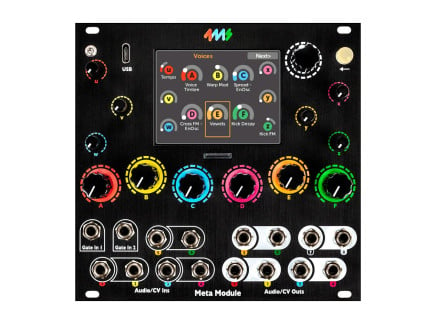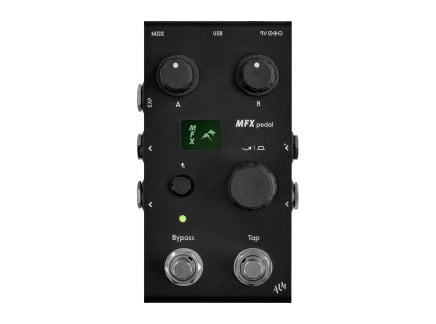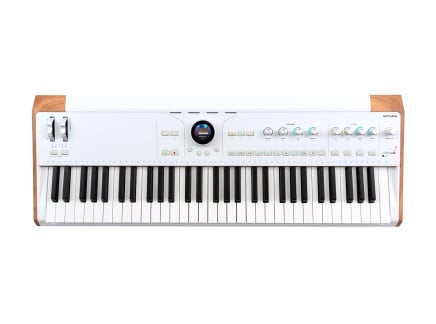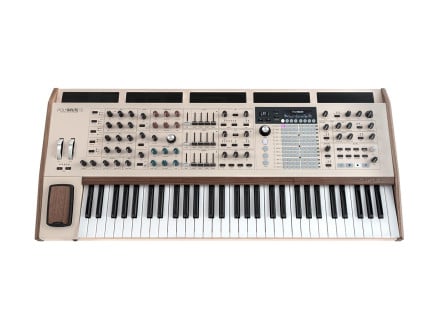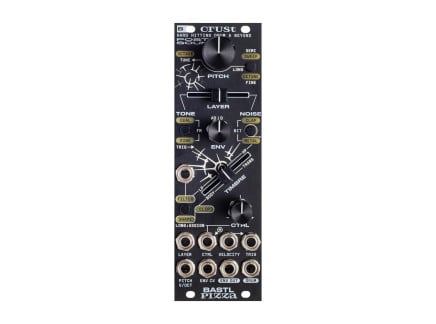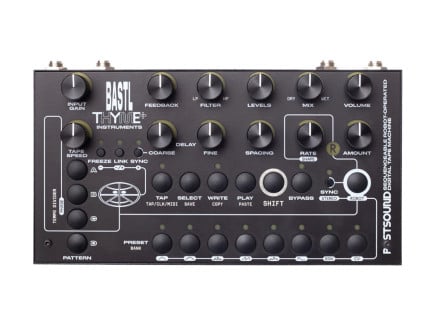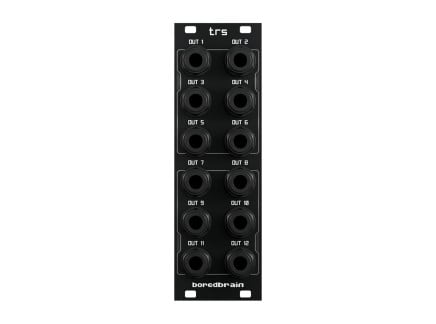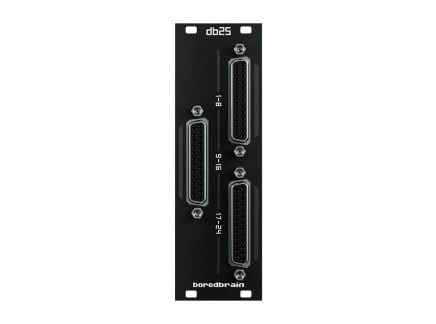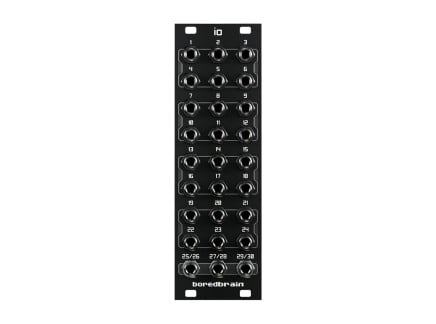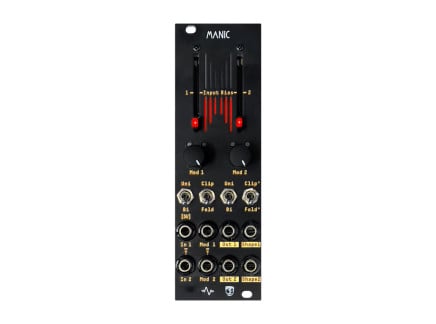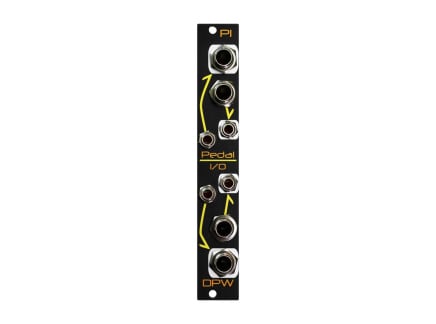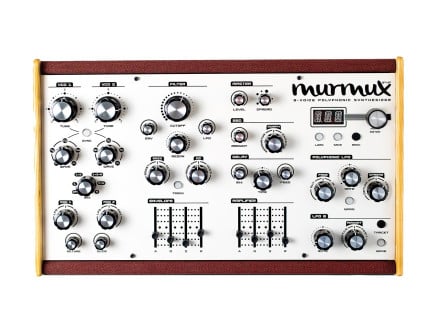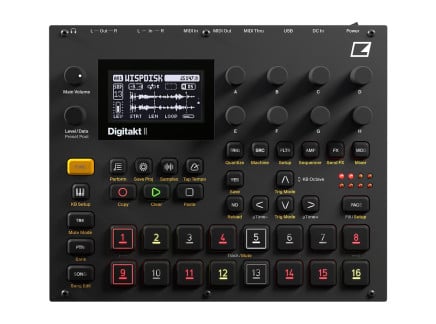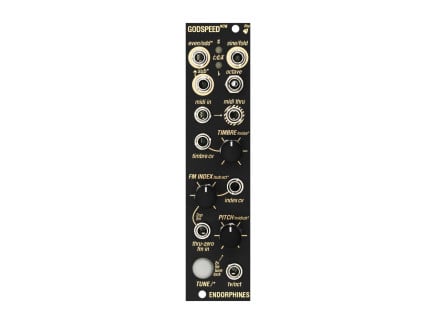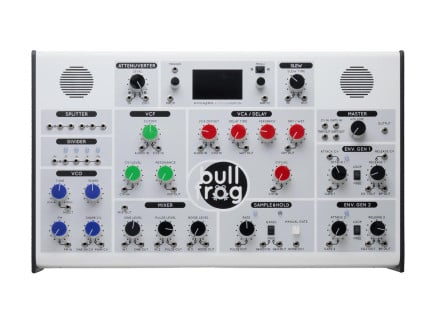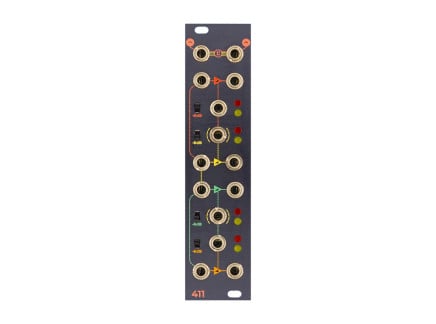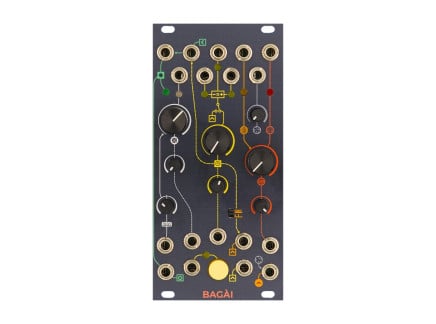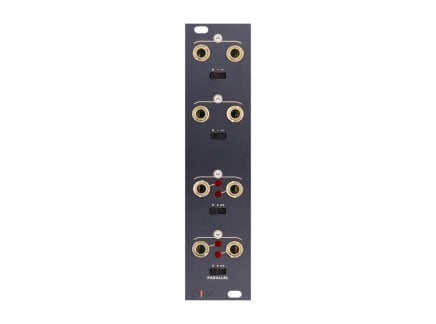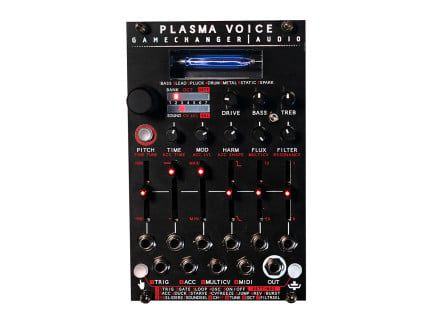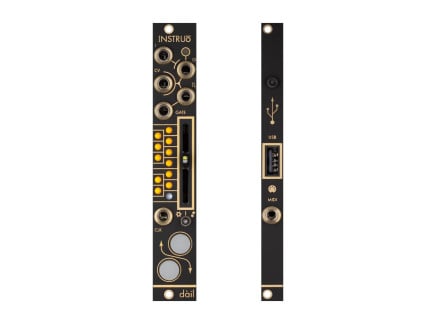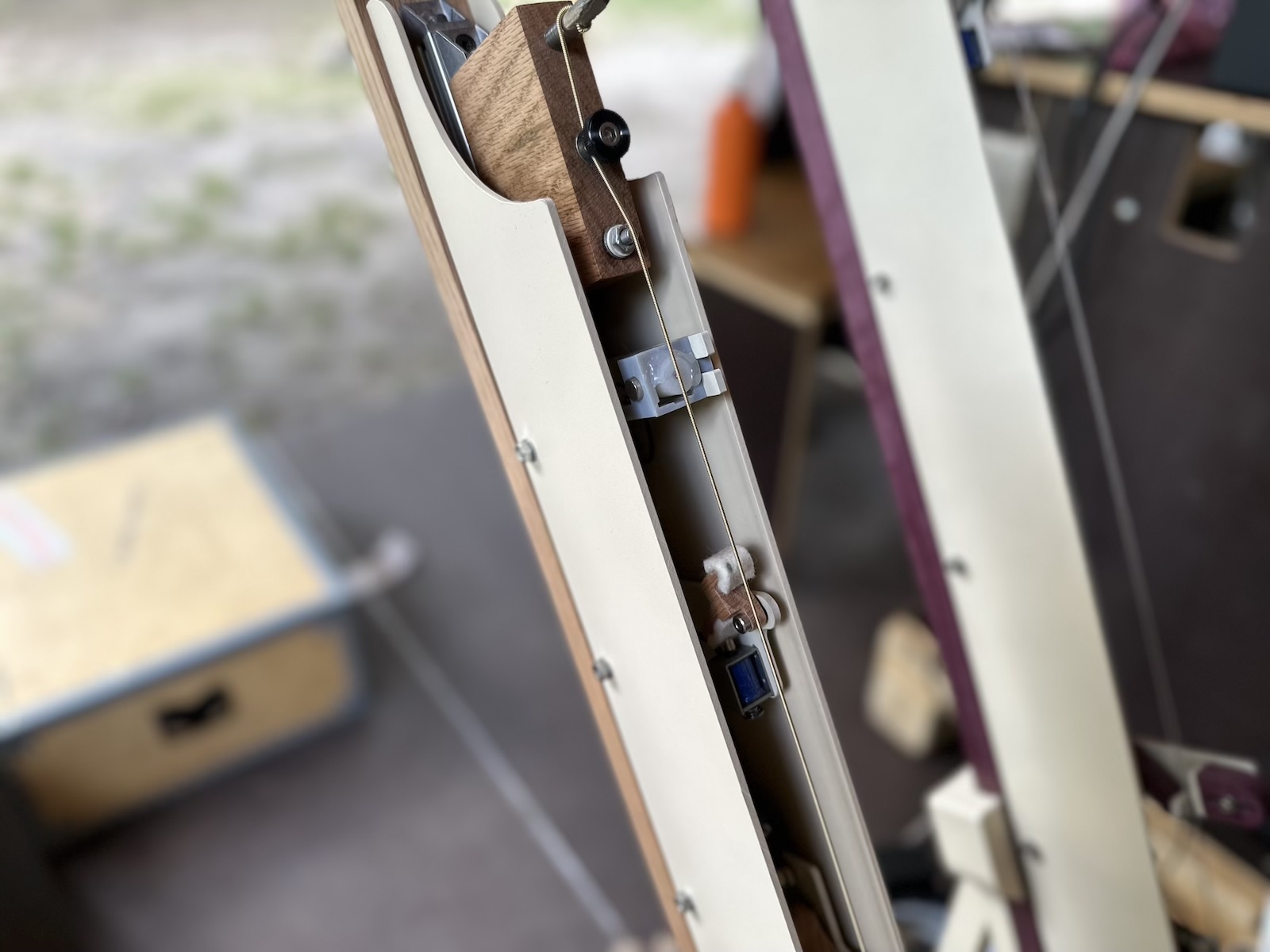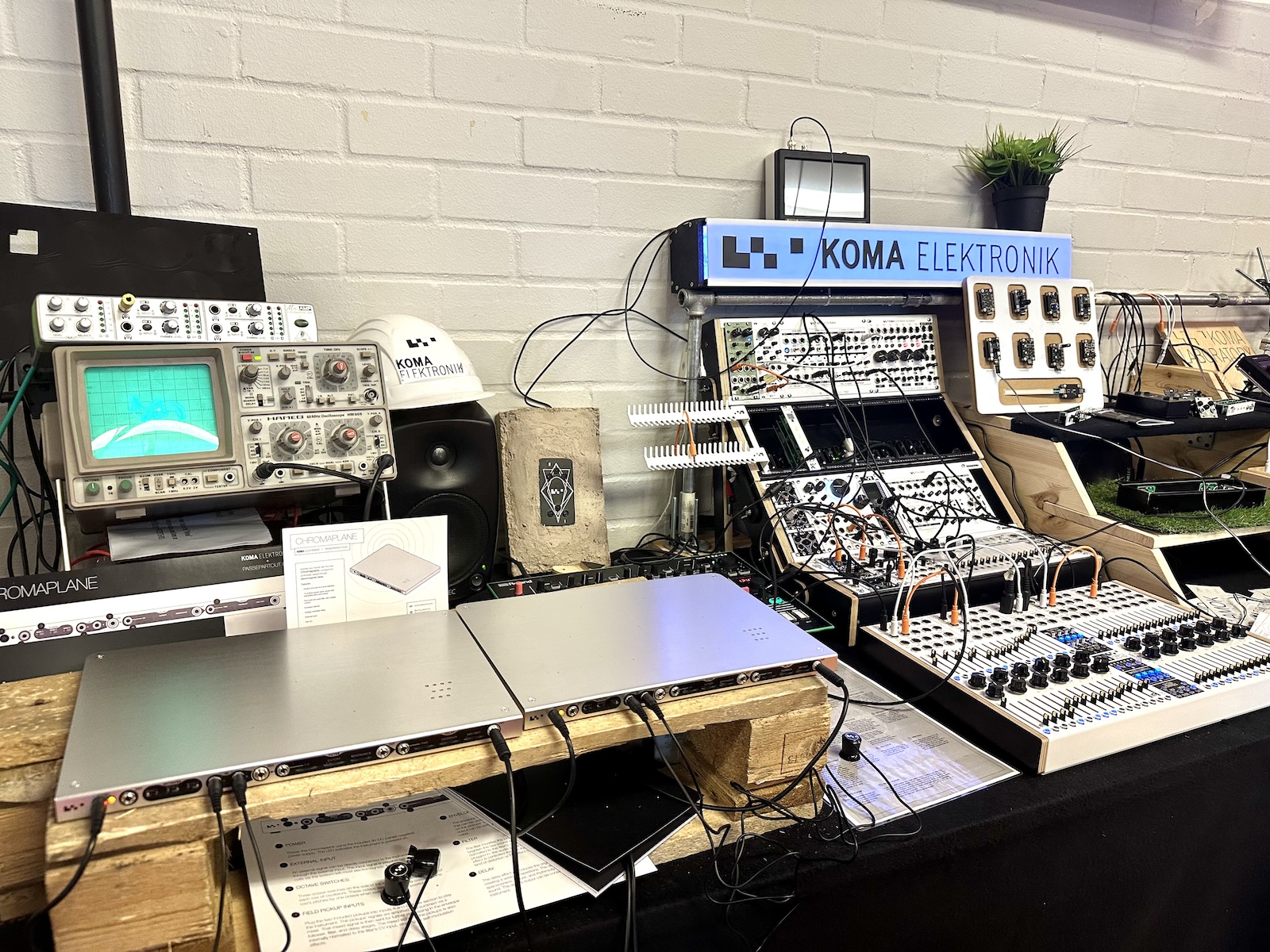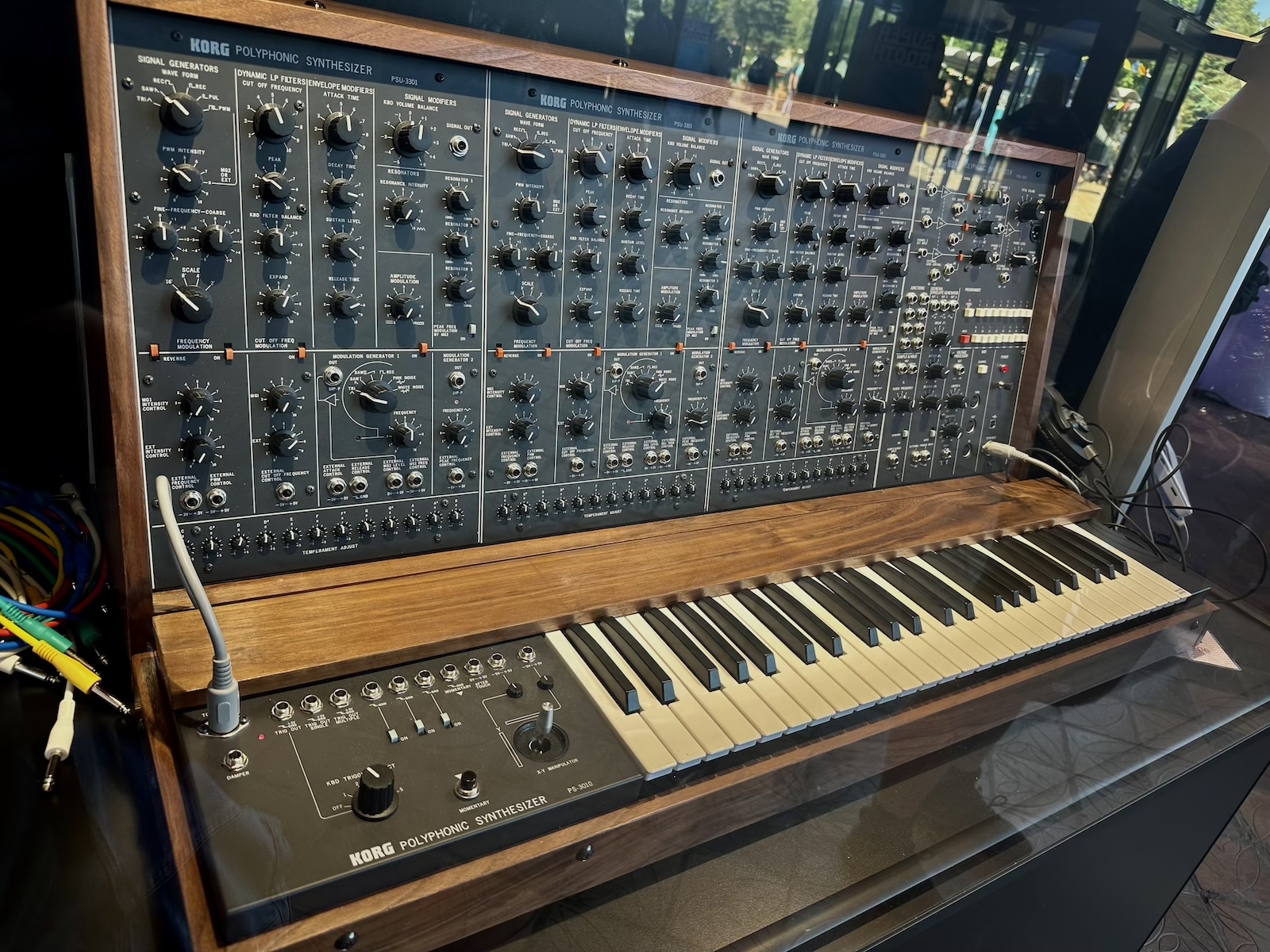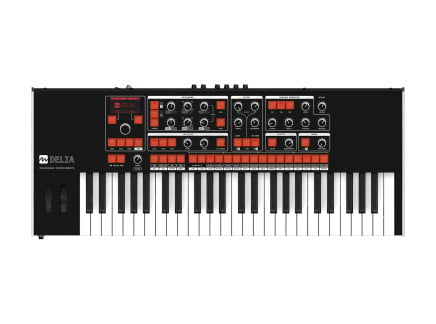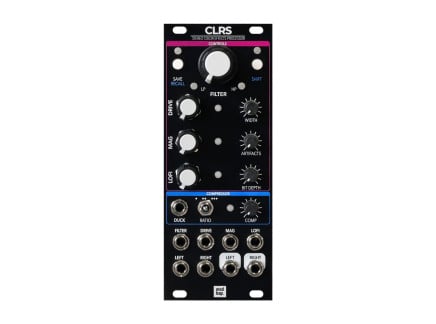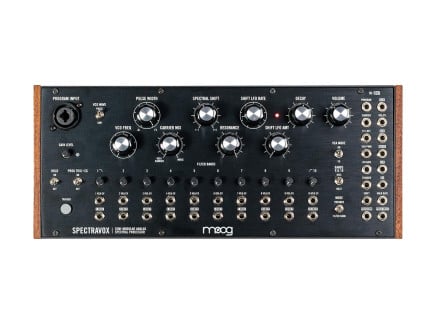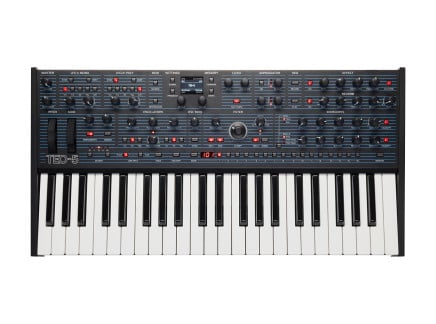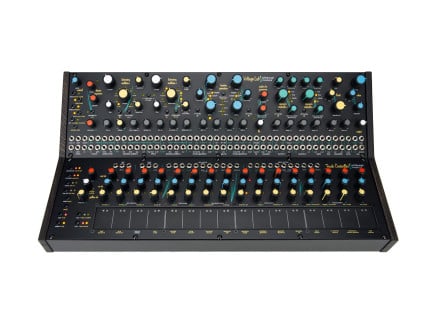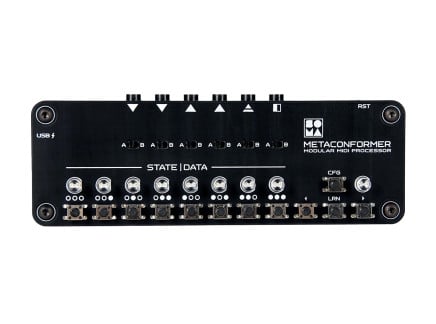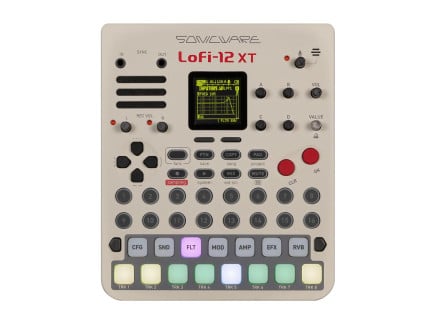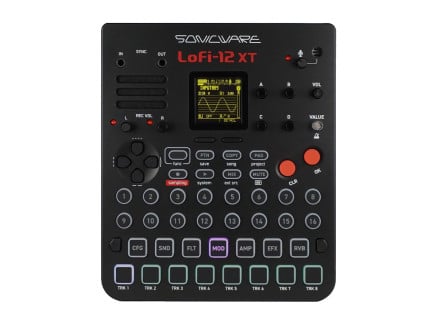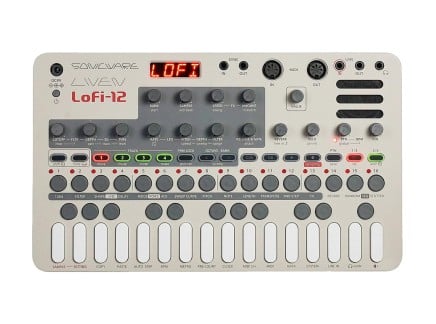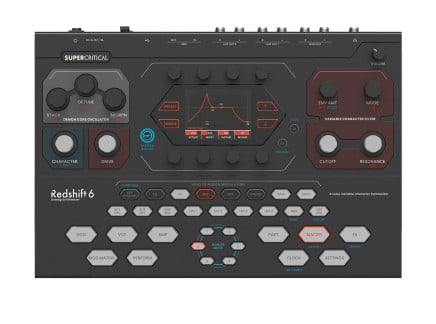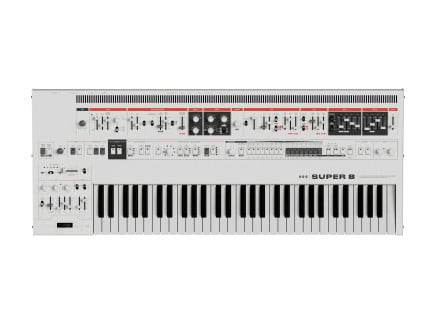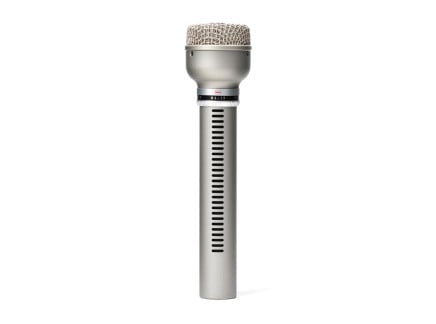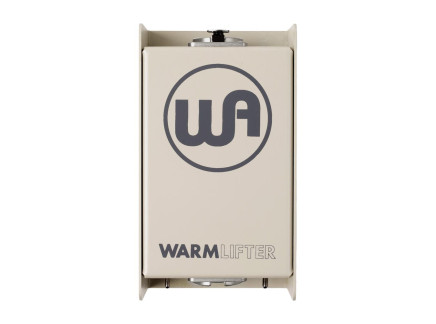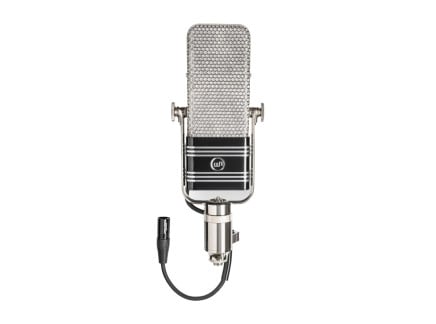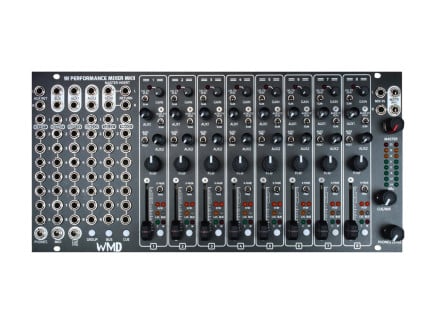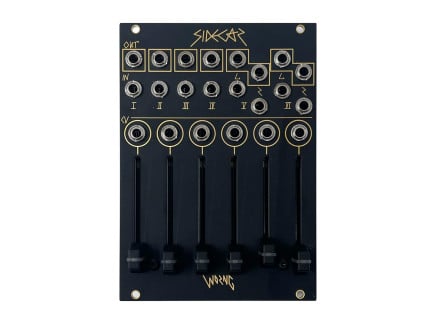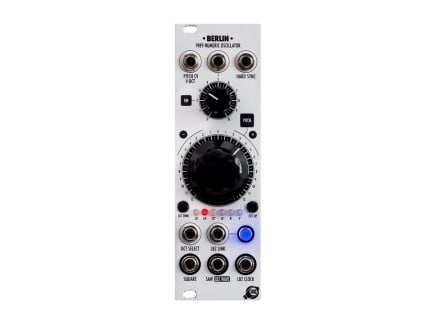Superbooth 2024 is here! We're on the ground in Berlin for the most exciting gear event of the year: new synthesizers, Eurorack modules, effect pedals, and more!
This year, we've already seen the new Pittsburgh Modular Voltage Lab 2, Moog Spectravox, Arturia Polybrute 12, ALM MFX pedal, and Erica Synths Bullfrog XL...with the promise of much more to come. Keep up to date with all the new announcements—we'll be updating our coverage regularly as we learn more!
4ms MetaModule
Having been teased and shown at prior events, 4ms arrives at Superbooth 2024 with a production-ready version of their MetaModule. Along with the reveal of an August release date, they're also providing more details about how MetaModule can be used and expanded.
MetaModule is a new approach to the "modular in your modular" idea that has taken off in the past few years. In this case, 4ms has effectively engineered a spin-off of the VCV Rack platform, running on juicy bare metal processors to operate with incredible speed and efficiency all within your Eurorack system. 12 knobs, two gate inputs, six DC-coupled signal inputs, and eight DC-coupled outputs are all assignable to virtual patch points and parameters inside of the currently running patch.
Thanks to its parity with VCV Rack, it is possible to design cross-compatible patches on the computer and run them on MetaModule, or vice versa. On launch, you can expect over 160 different modules to be available within MetaModule, ranging from essential utilities to complex physical modeling systems. This even includes designs from real-world modular makers, including 4ms themselves, Befaco, Mutable Instruments, and NonlinearCircuits. Plus, there are also some beloved VCV designs from the likes of HetrickCV and Scanner Darkly, and the forthcoming MetaModule SDK will make it possible for developers to add MetaModule compatibility to their VCV Rack plugins.
With a number of avid VCV Rack users and real-world patchers on our staff, we're excited to get our hands on MetaModule in the near future. 4ms announced that the module will be available on August 27th, 2024, but preorders are open now!
Acid Rain Technology MEMO
A surprise unveiling that grabbed our attention was MEMO from the folks at Acid Rain Technology, makers of beloved Eurorack modules like Chainsaw and Maestro. It's a self-contained modular synthesizer but without any physical patch points or cables! Instead, each section contains an array of push buttons and LED-encircled encoders, with a dedicated "Patch" button to designate the source of a routing connection. Tap a button or turn a knob with a downward arrow above, and your connection will be made.
As for the "modules" contained inside of MEMO, you'll find a varied assortment of sonic flavors and modulation options available. Two oscillators with slightly different feature sets between them, two state-variable filters, dual Serge-style function generators, three VCAs, an audio delay, and an abundance of utilities offer lots of possibilities. Of course, there's MIDI I/O to get external controllers involved, as well as presets and configurations for recalling patches on the fly.
MEMO is still in the prototype phase, but Acid Rain plans for this instrument to be available by the end of 2024.
ALM MFX Pedal
With many Eurorack modules under their belt and recent dabblings in plugins, ALM steps outside of the rack and into the effects pedal world for the first time with the MFX Pedal. We've cooked up a dedicated coverage article for the MFX Pedal, but you can keep reading here for a quick summary of what this little device is all about.
Based on their MFX multi-effects Eurorack module, the MFX Pedal aims to bring the same beloved collection of ALM effects to a broader audience. ALM has historically proven that they gravitate towards early digital-era sounds, and the effects in MFX Pedal align with this track record. From emulations of Lexicon and Alesis reverbs to busted-up, glitched-out electronics, MFX Pedal can provide some different flavors of effects than your typical multi-effects pedal.
Rather than offering CV inputs, the MFX Pedal features controls more suited to a self-contained pedal: assignable knobs, an expression pedal input, and tap tempo footswitch. Stereo input and output are retained, but a new analog gain stage is available for boosting particularly low-level signals into a more suitable amplitude range. There's also an external MIDI input, which allows for both MIDI Beat Clock synchronization and remote CC control of parameters.
ALM is shipping the MFX Pedal now, with the first units expected to arrive soon!
AMMT Clvtch
Although WMD previously announced they were ending production of their modules, we were delighted to hear that they would be returning—and pleasantly surprised to hear that certain modules would be passed over to a new offshoot company called AMMT. WMD favorites including Metron and their range of drum modules will soon be available again via AMMT, along with some fresh new designs as well. After their first appearance at Superbooth last year, AMMT returns again to show off a finalized hi-hat module named Clvtch.
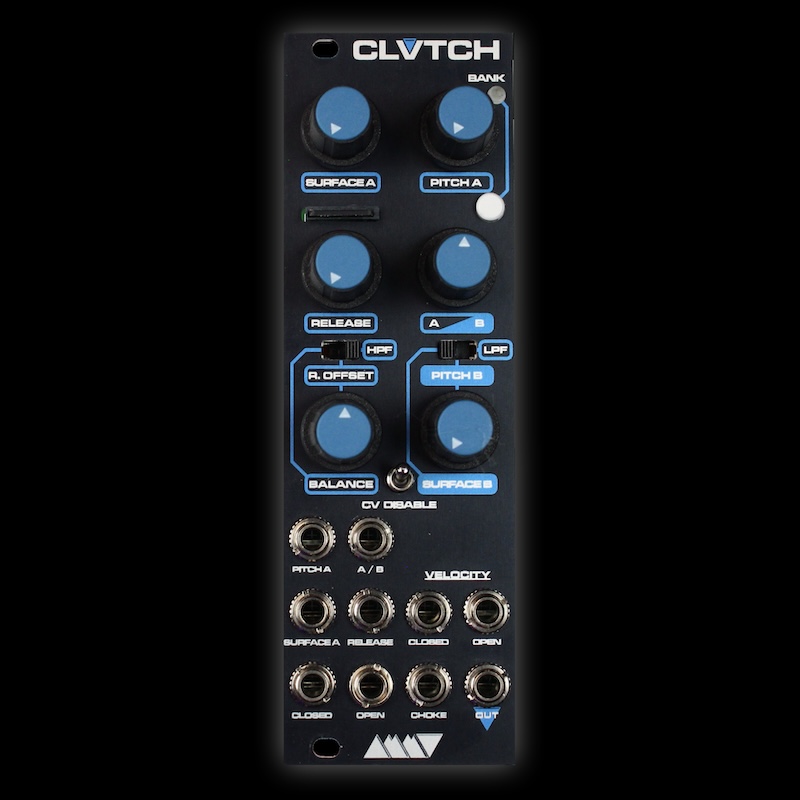
With a dual-layer interface, Clvtch allows you to easily blend samples to craft great-sounding hi-hats. Several samples curated by the AMMT team will be flashed into the module, but the user layer allows custom sounds to be loaded in via microSD card. Different sounds may be accessed with the Surface control, while the Bank button allows you to jump through different folders to call up alternative sound banks, kits, or however else you might like to organize your sounds.
In addition to Surface, Pitch A, A/B layer Blend, and Release controls, Clvtch features two assignable knobs that can be used for a variety of purposes. Tweak the pitch of the built-in samples, apply lowpass or highpass filtering, or skew the relationship in level and sustain between closed and open sound variants—the assignable knobs allow you to tailor Clvtch's parameterization to your liking! Of course, there's also a generous array of CV inputs, and a handy CV bypass switch allows you to performatively remove external modulation without needing to remove any connections.
Clvtch is expected to be available later this year for around $399, and we're eager to see what else AMMT might be cooking up.
Arturia Astrolab
The Astrolab brings Arturia’s famous softsynths and formidable hardware emulations into the physical realm with a well-built and stylish standalone instrument—no computer required. Astrolab ships with over 1,000 presets spanning 30 instruments from Arturia’s Pigments, V-Collection, and Analog Lab, packing multiple forms of synthesis, including subtractive, FM, and physical modeling patches.
Bi-timbral support allows you to split or layer two separate sounds across Astrolab’s 61-key semi-weighted keybed with channel aftertouch. Endless encoders encircled by light rings for visual feedback facilitate broad timbral shaping. While more detailed patch editing requires a computer along with the appropriate software licenses, USB and Wi-Fi connectivity make quick work of transferring patches between a computer and Astrolab. There are also four controls dedicated to two insert effects that can be applied to patches individually and two global effects that are applied to your entire soundscape.
Astrolab’s included performance features make it an ideal live solution with an onboard arpeggiator, chord modes, scale modes, and even a MIDI looper for recording and repeating musical phrases live. No corners were cut when it comes to connectivity either, with four pedal inputs for sustain, expression, and two aux pedals, along with MIDI in and out, and a USB port that can be used to add on an additional midi controller or more storage. You couldn’t ask for a more premium or flexible way to bring your Arturia sounds to the stage
Arturia Polybrute 12
Every once in a while, a keyboard comes along that makes you wish you had twelve fingers. Arturia's new Polybrute 12 is exactly that kind of instrument: it's a 12-voice polyphonic update to the original Polybrute concept. While that alone should be enough to entice anyone familiar with the original, there's more to it than that. Sure, it has the same incredible sound engine, open-ended matrix modulation, and parameter morphing from the original...but it also packs a number of new tricks up its sleeve, all aimed toward the exploration of new expressive possibilities.
Namely, Polybrute 12 is the first unveiling of Arturia's new FullTouch keyboard technology. We've dedicated a full article to discussing FullTouch, so refer to that for greater detail...but the basic premise is this. While it has become increasingly common for commercial instruments to employ polyphonic aftertouch, typical PolyAT implementations have some disadvantages: namely, they require to full depress the key before the aftertouch is capable of responding.
In Polybrute 12, this isn't the case. Polybrute 12's keybed can detect continuous vertical key displacement: allowing you to use the entire travel of the key as a source of polyphonic expressive control data. The keys can trigger with the slightest touch: and then, the full range of the key's motion can be used in the modulation matrix to affect any combination of parameters you desire. What's more, the key response can be divided into two regions as well: and once the first "level" of aftertouch reaches its maximum, the second level kicks in (and offers its own independent assignments in the mod matrix). In a separate mode, the key activity can be internally used to control the envelope behavior—resulting in an uncommonly organic, natural-feeling key response.
The keyboard can transmit MPE data; and happily, if you prefer to use standard synth action, it can facilitate that as well with a simple menu option. So, you don't need to use all of the FullTouch features—and even when using standard synth action response, you'll be pleased to feel the remarkably well-designed custom keys. They are an absolute pleasure to play, FullTouch engaged or not.
The original Polybrute already presented an incredible value proposition: in our minds, it's one of the most interesting-sounding and flexible polyphonic analog synthesizers ever developed. We're happy to see Polybrute 12 advance the design through an intensified focus on expressive control: and of course, the extra polyphony won't hurt. Even if you prefer to approach it without exploring FullTouch, you're getting one heck of a synthesizer—but we suspect that, in the near future, people will describe Polybrute 12 as being the same type of expressive revelation that the Yamaha CS-80 was in its own time. It's a step into the future, and we're happy that we've finally caught up to it.
ASM Hydrasynth Anniversary Edition
The Hydrasynth is getting a gleaming new look to commemorate this incredibly versatile instrument’s 5th anniversary. This limited edition run of the Hydrasynth Keyboard and Hydrasynth Deluxe will feature a sparkling silver finish, custom-made side panels sporting the Hydrasynth logo, and a 5TH ANNIVERSARY SILVER EDITION label on the top panel to distinguish these rare gems from their counterparts.
The Silver Edition package extends into the aural realm as well with an exclusive patch bank from a team of specially selected sound designers. Lastly, you can extend your ASM pride to your car or flight case with an exclusive silver sticker that completes the Anniversary package.
Look on any synth forum, and you’re bound to find countless Hydrasynth recommendations. And for good reason, as it’s simply one of the most complete sound design packages you can get in its price range; with polyphonic aftertouch, a robust sound engine, modulation galore, and a panel that’s a delight to program, it’s a tough proposition to find a better value synthesizer. We're accepting orders for both models now!
BASTL Crust & Thyme+
We're big fans of the BASTL Instruments crew here at Perfect Circuit, as they're always putting out some of the most unique and interesting stuff around the Eurorack scene. For Superbooth 2024, BASTL is revisiting a couple of their past designs and bringing some new ideas out of them.
Following Pizza and Basil, now BASTL offers Crust: a powerhouse drum voice packed into just 8hp. Crust allows you to dial in a dual-oscillator Tone generator and blend it with a flexible Noise source, the various combinations of which can lead to variety of metallic and membrane percussion sounds (and beyond). Add in the additional filtering and tone-shaping stages, and Crust can cover all of the spaces between drum and melodic instrument.
Going back further in BASTL's history, Thyme+ is an updated version of their original desktop delay device. Though it certainly sounds digital (and isn't ashamed about it), Thyme+ draws a lot of inspiration from analog tape machines, featuring a virtual Tape Speed control. You can also position multiple playheads along this "tape," while additional filtering and gain stages allow you to build everything from slapback echoes to murky pseudo-multitap sounds. An optional Karplus-Strong mode even lets you use Thyme+ as a synthesizer!
Thyme+'s most unique feature though is its Robot modulation system—in line with the tape metaphor, imagine little robots moving knobs and settings on a real-life tape deck. Of course, in the context of a digital device like Thyme+, these are just virtual LFOs—one for each of Thyme+'s primary parameters. But beyond just offering periodic waveforms, a Robot can also be configured as an envelope follower, or accept input from an external control voltage source. Add in the ability to sequence and recall different presets, and Robots clearly go well beyond what your typical modulation source can do.
Announced the week before Superbooth, BASTL is planning to ship both Thyme+ and Crust by the end of May 2024.
Befaco Oneiroi
Befaco has already been on a streak of releasing new modules this year, but for Superbooth 2024 they're putting out their most ambitious device yet. Oneiroi is a complex sound source and effects processor, specializing in experimental ambiences and drones.
Oneiroi is based on Rebel Technology's OWL mk3 platform—Befaco has collaborated with these folks in the past, so it's a sensible match for a sophisticated digital module like Oneiroi. In addition to stereo audio inputs, Oneiroi offers three built-in oscillators for crafting rich timbres: a sine wave, a stereo supersaw, and a dynamic wavetable that pulls from the internal looper buffer. Speaking of, this looper can record either the stereo audio input to record the entire module's output, giving you a lot of variety in source material for your wavetables. The looper can also separately be used for classic varispeed looping tricks, supporting up to 2x playback speeds forward or backward.
In addition to being a flexible sound source, Oneiroi also provides an abundance of effects processing blocks. The multimode filter offers lowpass, bandpass, highpass, and even comb filter responses, with the option to place it anywhere in the signal chain for maximum flexibility. Add in the 3-band resonator, 2-tap echo, and 1-knob reverb, and you've practically got a complete rig for crafting soundscapes packed into one module.
If that isn't enough, Oneiroi also features internal modulation that can be routed to numerous destinations. Of course, there are also plenty of CV inputs for most parameters. A randomization feature also lets you spice things up on the fly, with variable intensity and an undo/redo safety net to keep your patches tethered.
Oneiroi is being shown at Superbooth 2024, and is expected to be available later in the year.
Bjooks: The Minimoog Boog
Some instruments have such an impact that they deserve their own analysis, observance, and appreciation. In the case the iconic Minimoog, we’re getting an entire book presenting a visually beautiful deep-dive into the instrument that brought the Moog sound to the stage.
The Minimoog Book comes from BJOOKS, the creators of awesome synthesis reads like Push Turn Move, Patch and Tweak, and Synth Gems. The book will cover the Minimoog from three perspectives with original research and visuals, including a detailed chronology of the instrument’s development up to the present day—as well as over 70 musician interviews, and exclusive interviews with engineers who worked with Moog before and throughout the Minimoog's lifetime. There will also be descriptions of iconic Minimoog patches complete with diagrams. The bow on top is a foreword by Rush frontman Geddy Lee.
The Minimoog Book isn't available for sale through retailers yet—but currently, BJOOKS is hosting a Kickstarter campaign to fund its development. Head to Kickstarter to support The Minimoog Book!
Black Corporation ISE-NIN Voice
Black Corporation, famous for their vintage synth recreations, are bringing the sound of the Jupiter 8 to modular, with ISE-NIN Voice. Spawning from the same DNA as Black Corporation’s ISE-NIN Jupiter 8 replica, ISE-NIN VOICE is a full synthesizer in its own right, giving you the equivalent of one/eighth of the ISE-NIN in Eurorack form: you’ve got the two rich oscillators, the filter, the envelopes, and the modulation, it’s all there.
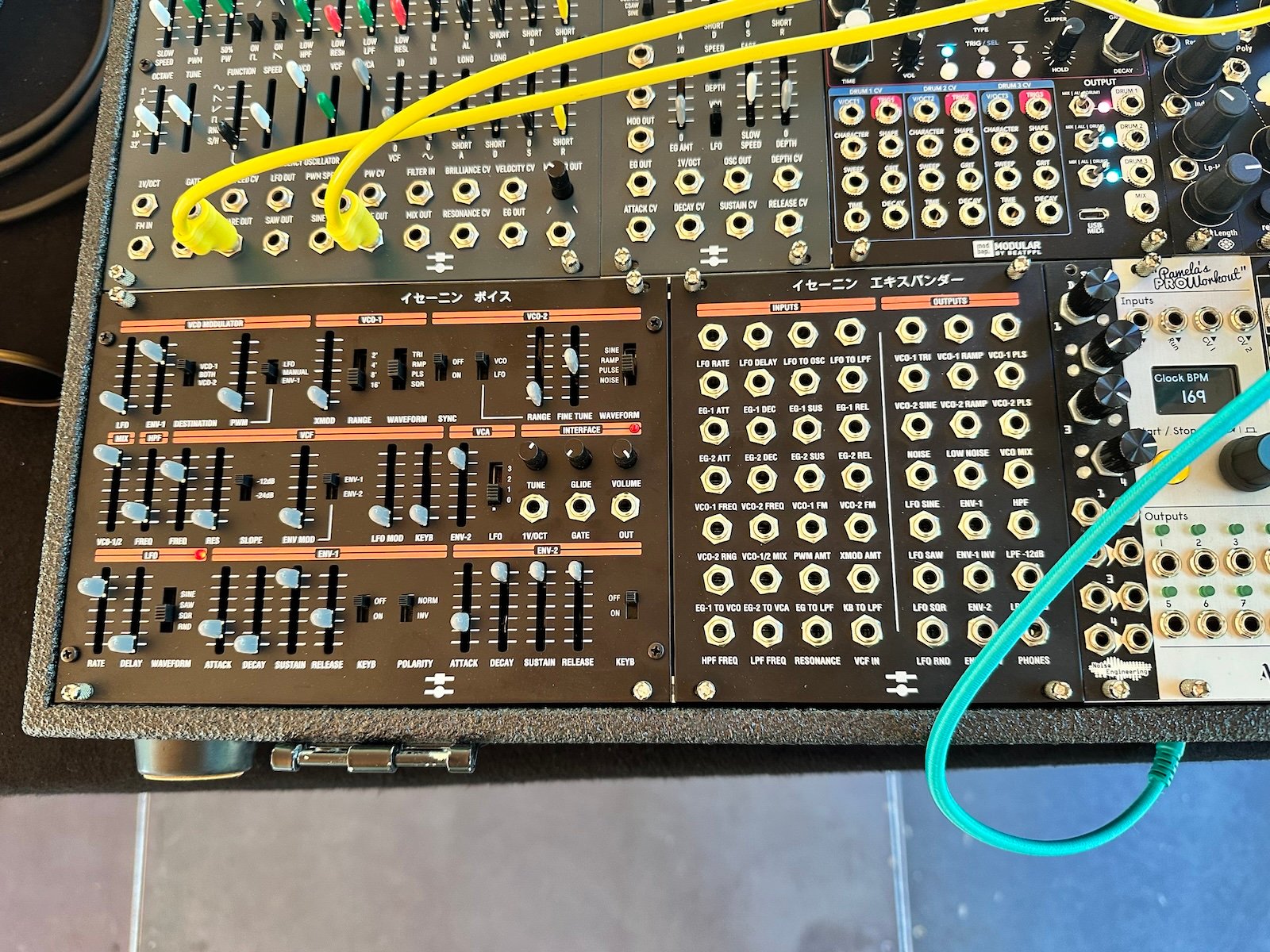
In case you’re unfamiliar with the ISE-NIN, this means you get a lot of vintage vibe functionality packed into 36HP. The oscillators combined can produce five waveshapes, including sine, plus noise. An oscillator modulation section includes dedicated PWM, and controls that allow one of the envelopes and one of the LFOs to influence either or both oscillators. You’ll find that classic Jupiter 8 character in ISE-NIN VOICE’s robust filter section which includes a high pass filter and dual-sloped low pass filter (-12db and -24db). Two envelopes, keyboard controls, and a 1v/oct and gate input complete this self-contained voice from the past.
But who wants to stop there? Fully assimilate ISE-NIN VOICE into your rig with the ISI-NIN Breakout, which opens up every parameter on the ISE-NIN VOICE to external influence, including the oscillators (plus FM mod), filter, and every stage of the envelopes. ISE-NIN VOICE and ISI-NIN breakout start shipping in July.
Black Corporation Kijimi MK2
The geniuses at Black Corporation have a new iteration of their RSF Polykobol II-inspired Kijimi MK2, managing to condense the 8-voiced analog bundle of modulation goodness into a slim package that weighs in under 6lbs—a huge downsize from the 4U rackmount enclosure of its predecessor.
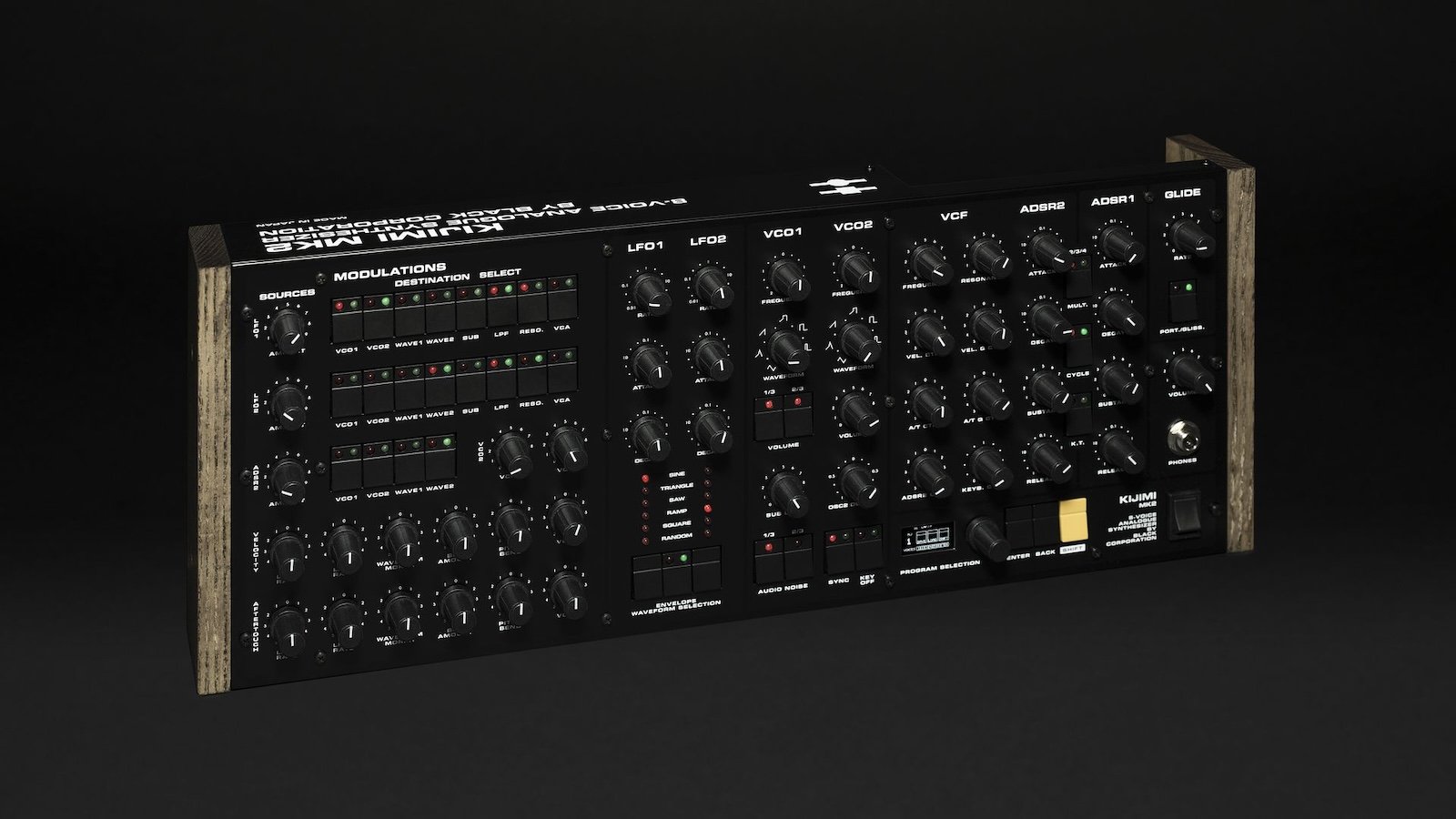
Despite its vintage inspiration, the Kijimi is one of the most original and ambitious analog polysynths out there. Each voice contains two oscillators that can continuously morph between several waveshapes. Its knob-per-function panel features a dense modulation matrix composed of dedicated buttons for each assignment unlocking a potential for patch sophistication and complexity that’s unprecedented in a polysynth of this caliber. All this combined with other unique features like a trapezoidal looping option for the envelopes and polyphonic aftertouch make the Kijimi one of those instruments capable of patches no other single piece of hardware can achieve.
Along with the spatially economical redesign, the Kijimi MK2 ships with new firmware that allows different LFO settings for each modulation destination, plus new expertly-designed patch banks. The Kijimi MK2 is set to start shipping out in July.
Boredbrain Xcelon Expanders
2023 felt like the year of big Eurorack mixers, and one our favorite options to come out of it was Boredbrain Music's Xcelon. With a Goldilocks feature set and promises of future expansion capabilities, Xcelon quickly became a top choice for serious Eurorack mixing tasks.
Released a couple of weeks before Superbooth 2024, Boredbrain finally introduced the first handful of Xcelon expander modules: IO, TRS, and DB25. With a focus on getting signals in and out of your rack, these expanders can also be used on their own in various combinations—interfacing between different connector formats.
IO is the most universal of the three expanders—connect it with one of the others to breakout signals to patchable 3.5mm connections, or pair with Xcelon for 15 direct output channels. TRS operates similarly but gives you 1/4" balanced outputs to connect with audio interfaces, samplers, effects processors, and more. And for the most professional of pro audio rigs, DB25 interfaces with snake cables, mixers, and other DB25-equipped gear.
All three Boredbrain expander modules are available right now!
Side note: we recently interviewed Adam from Boredbrain about all things Xcelon and these new expanders—give that a read if you're interested in more in-depth details!
Boredbrain OPTX V2
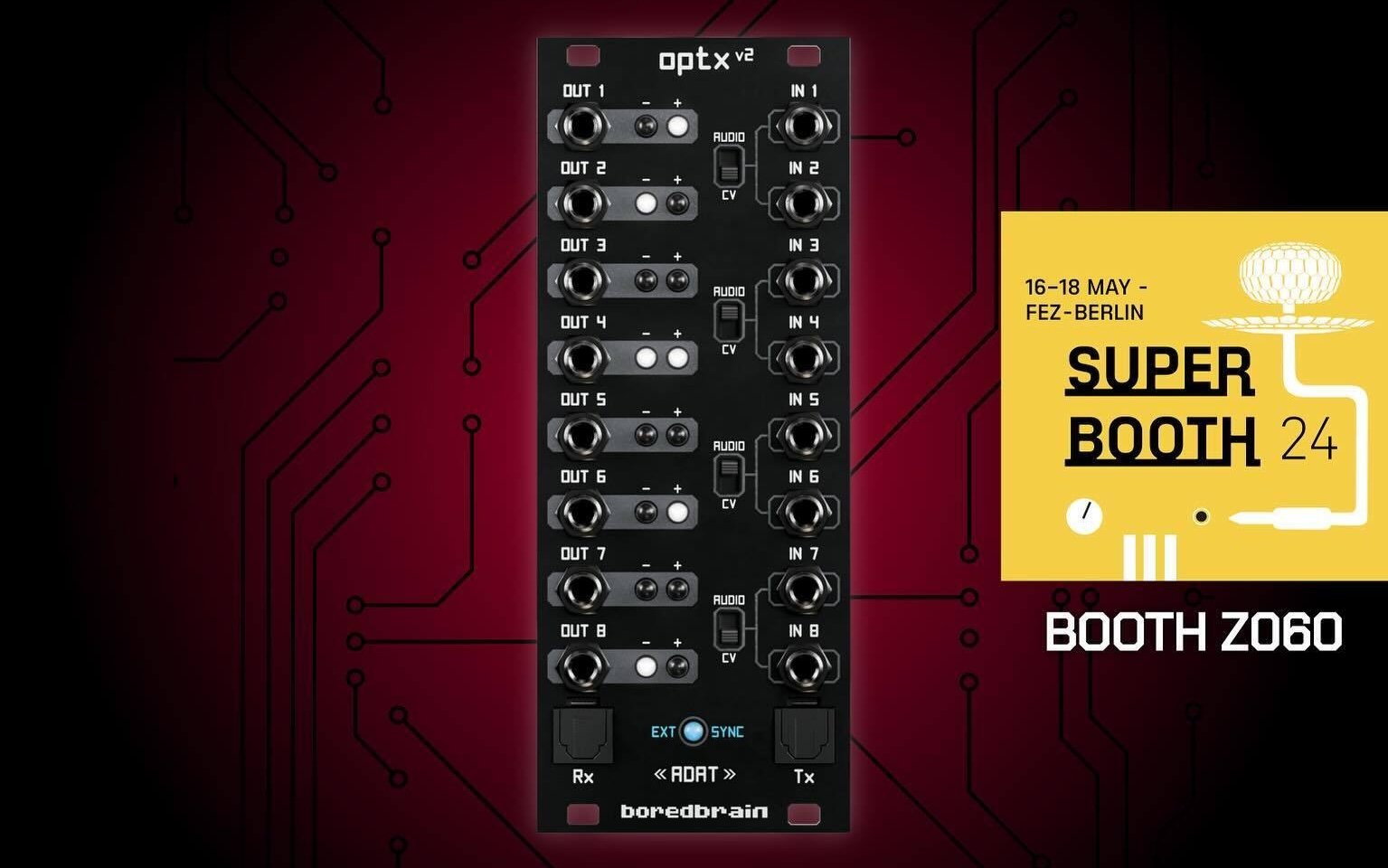
Surprise! Boredbrain had one more trick up their sleeve for Superbooth 2024: the public debut of Optx V2. Details are a bit light right now, but here's what we know so far. Like the original, it's an ADAT optical interface for Eurorack modular systems—connect it to the lightpipe ports of your audio interface, and you've got an additional eight inputs and eight outputs available right in your system.
Boredbrain took the chance to refine the capabilities of the original, ensuring that Optx V2 is a flexible and dependable interface for your rack. Notably, noise performance has been greatly improved, and each pair of inputs offers selectable AC or DC-coupling to support optimized analog-digital conversion of audio or control voltage signals.
We're excited for this module to be available later this year—stay tuned for details!
CHAIR Analog Waveguide
We're certainly big fans of bizarre signal processors here at Perfect Circuit, which is why we're particularly excited by the Analog Waveguide. Designed by the folks at The Center for Haptic Audio Interaction Research (or CHAIR for short), the Analog Waveguide is an implementation of a reverb concept first described by Michael Gerzon in 1971—limited at the time by available technologies, and thus unable to explored at the time. Though a few digital recreations exist, the Analog Waveguide is the first to actually do it with...well, analog parts!

With bucket brigade delay (BBD) chips inside, the Analog Waveguide doesn't have enough delay time to create convincing reverberant spaces, but what it can do is create a wealth of resonator and physical modeling effects. The two delay lines are tightly controlled and visualized with an XY display. A variety of controls for rotation allow the virtual space or body to continually shift either manually or via control voltages.
More information about availability for the Analog Waveguide is expected later in the year—this is one we're really looking forward to!
DATO Drum
Dashing around Superbooth on a yellow umbrella-laden cart, DATO, makers of the Duo synthesizer for two, is showing off their new product: Drum. This octagonal-shaped instrument is a four-part drum machine, with voice parameters and performance features dispersed around its not-quite circular surface. Like the Duo before it, it's designed to be a fun instrument that should be enjoyed with a companion—any age, any experience level.
More information on the DATO Drum is due in the coming months.
DivKid x Apollo View Manic
DivKid is back with another collaborative module—this time produced in conjunction with Apollo View Modular. We're talking about Manic: an all-new stereo VCA with saturation and a variety of flavors of both clipping and wavefolding. You can use it as a stereo VCA or as two mono VCAs—and you'll find it a pleasure to patch in a variety of scenarios.
Manic is fine-tuned for stereo operation, with perfectly matched gain on both channels. Both the signal inputs and CV inputs are normalled from one channel to the next, making it easy to do true stereo or mono-to-stereo gating effects. Of course, when patching different signals into each channel, they can be used independently as well. Large, front panel bias controls and CV attenuators toward the top of the panel make it easy to reach the most critical controls at a moment's notice, with all signal I/O at the bottom of the module. That might seem like a weird detail to report on, but in my opinion, it's a nice touch.
Another nice touch—the VCAs can be switched into a special "bipolar" mode, in which they act as ring modulators. Happily, the input bias sliders switch to logical levels when you switch from unipolar to bipolar mode: in unipolar mode, they produce 0–5VDC, and in bipolar mode, they produce -5–5VDC, allowing for everything from unity to inverted unity signal scaling. Neat! Oh, by the way, it's also DC-coupled—making it a great utility for scaling audio or CV signals.
But that's just part of the story: DivKid refers to Manic as a set of VCAs with superpowers...so, what are these superpowers? Clipping and wavefolding, my friend. You'll notice that each channel has two outputs: Out 1/2 and Shape1/2. Each channel also has a three-position switch labeled Clip/Fold, which governs the behavior of each respective Shape output. In the middle position, the Shape outputs produce inverted copies of their respective VCA signal outputs. In the upper position, they produce clipping effects: on Channel 1, this introduces classic hyperbolic tangent clipping; on Channel 2, this produces hard clipping. When set to fold, Channel 1 offers a Serge-style wavefolder, whereas Channel 2 provides Buchla-style wavefolding effects.
The end result? An uncommonly flexible VCA and tone-shaping tool, sure to cover your bases for standard utilitarian functions while also providing a host of timbre-altering effects. It's a solid and well-thought-out package, and we're stoked to see how people will use it.
DPW Design P1 Pedal Interface
DPW Design presents the all-new P1, a dual-channel pedal interface designed to be the perfect bridge between your effects pedal collection and modular system. By attenuating and amplifying signals where appropriate, you can experience better Hi-Z instrument tone and better (or more expected) interactions with certain pedals. Created with care by DPW Design, the P1 pedal interface also hosts a few thoughtful tidbits that make it a first-class utility module.
Split into two independent halves, the module can be used in dual mono or as a stereo interface. When routing from Eurorack to pedals, the signal is attenuated -18dB, and going from pedal, guitar, or bass to Eurorack, the interface performs the inverse, amplifying the signal by +18dB. Symmetrical soft clipping on the Eurorack input will prevent harshness and offer sonically creative applications. The pedal input comes with a suitably-calibrated limiter to prevent harsh transients.
It’s become so common to mix pedals and synths that it’s easy to forget we’re often feeding signals far hotter than the pedals are designed for. You may be surprised at how much better some pedal/synth interactions are with the right attenuation.
Dreadbox Murmux Adept
Murmux Adept is a limited-run release, trading the prior Murmux’s semi-modular status for eight voices of rich analog character. Each voice features 2 VCOs, a low-pass ladder filter with a few tricks, filter and amp ADSR envelopes, a very unique BBD delay, another more conventional delay, and wraps it up with two LFOs, one polyphonic and one global.
While that’s a list any analog polysynth would be lucky to have, it’s far from the full picture. Aside from its clear sonic character, the Murmux magic is in its effective panel and several unique offerings designed to pull out new sounds.
The tasteful retro design is complemented with a strictly knob-per-function interface that manages to present a healthy amount of choices for sound shaping without a shift function in sight, all while keeping the experience surprisingly visual. The two dedicated sets of ADSR envelope faders, LFO LEDs, and a large LED numeric display all do their part to make this happen. But the Murmux takes a sharp turn for originality with several pots that make efficient use of positive and negative directions, often offering different choices on the same knob. Fittingly, it’s many of those bi-directional pot controls that hold sounds exclusive to the Murmux: a filter bass boost/hi-cut, a filter FM mod knob that switches between noise and VCO 2, a BBD delay control that selects a resonator or big-sounding chorus, LFO fade in and fade out, and more. It’s these powerful rarities that will likely characterize the sound of Murmux Adept patches.
The Murmux Adept is limited to 300 units globally.
Elektron Digitakt II
A modern classic evolves into a more powerful form with the Digitakt II. From just about every angle, the second iteration increases in capability over its beloved predecessor; sampling, audio processing, sequencing, and storage all get substantial improvements.
New possibilities come with the Digitakt II’s 16 audio tracks (any of which can be assigned to midi duty) and support for stereo sampling, unveiling whole new aural landscapes to craft and a lot more fidelity in the width dimension of your tracks. And you now have more storage to hold those bigger stereo samples: Digitakt II comes with 36 minutes of stereo sample storage or 72 minutes of mono sample storage, with overall storage capacity increased to 20GB. You can record longer samples, too, up to 66 seconds long (33 seconds for stereo).
You’ll also find new machines lurking in the menus. A new Stretch playback machine allows for cleaner time warping and pitch shifting. Perhaps the most timbral impact comes from the new filters, a multi-mode morphing filter, a 4-pole low pass filter, and a comb filter all make their debut in the Digitakt II. There’s also a new Euclidean sequencer, new trig modes, 16-note polyphony, and a lot more—it’s certainly a worthy successor.
(We published a full article going over Digitakt II's new features—you can check it out here!)
Elta Music Solar 42F
Elta Music’s Solar 42 gets a small but meaningful update in the Solar 42F. A stereo distortion now sits just after the Solar 42’s Polyvox filters, offering a final touch of saturation before the audio hits the effects. Additionally, many of the Solar 42F’s knobs are color-coded, a logical step considering this sefl-contained soundscape system contains dozens of knobs and controls.
The Solar 42 is aimed directly at ambient artists, unapologetically declaring itself an Ambient Machine right on the panel. And indeed, it is an ambient machine if there ever was one. The Solar 42 is designed to produce new aural worlds all its own, which it accomplishes by offering a very specialized set of sonic tools.
The player controls an analog choir of 42 oscillators split into eight voices. But the voices are far from identical. Three types of voices each offer different qualities to a composition. Four are dedicated drone voices that can be tuned into chords. Two voices include FM and amplitude modulation for stranger, harsher, and/or more rhythmic sounds. The final two voices are the melodic voices, with a full set of wave shapes and ADSR envelopes. This separation of duty and design in the Solar 42 effectively creates several instruments under the same panel, yet it’s thoroughly cohesive with tons of patch points and a unifying pair of characterful polyvox filters. But this description hardly scrapes the surface of this instrument’s feature set. With so many creative ideas baked into the panel, unique doesn’t begin to describe how different the Solar 42 is—it’s the ambient powerhouse we didn’t know we needed.
Embodme Erae II
The most customizable MPE controller just got a whole lot better with the Erae II. While there are new features galore, the more foundational improvements are the most exciting: Erae II will have better touch sensitivity and improved pressure dynamics paving the way for an even more emotive controller that pulls your creative instincts closer to your MPE-powered performances.
Some immediately noticeable differences are a wider surface covered with a sanity fabric; however, percussive players will still have the option of a more suitable silicon covering. Two rows of dedicated buttons allow for quicker switching between layouts, control of a built-in looper, and a control wheel and top-right screen allow for changing CCs and potentially other settings directly from the Erae II.
We are particularly excited for Erae II’s 12 stereo CV outs (yes, as in 24 CV outs total) that will allow for integration with modular systems, a truly exciting proposition that you can’t help but speculate on its future utilization. Erae II isn't available just yet—but we're excited to get our hands on it.
Endorphin.es NEW Godspeed + More
For Superbooth 2024, Endorphines has rolled into Berlin with a revamped versions of a couple of their modules.
Expanding their line of 1U offerings, now Endorphines is offering the Autopilot 1U: a compact single-channel version of their oscillator tuning utility. With this module, even the most unruly of analog oscillators may be tamed to track in tune. Simply patch a spare waveform output into the Reference Input of Autopilot, and route your desired 1V/Oct source through as well. Tap the tune button and Autopilot can bring the module up or down to the closest A or C note, and from there you can rely on it tracking across the highest of highs and lowest of lows.
A slightly bigger update comes in the form of NEW Godspeed, a revised version of their compact oscillator module. Notably, NEW Godspeed features both 1V/Oct and TRS MIDI inputs, giving you the flexibility to work with any source of pitch information whether its analog or digital. An integrated Autopilot tuning system also ensure that NEW Godspeed is able to lock in as needed.
Like their Strong Zero VCO Core for the Furthrrrr Generator before it, NEW Godspeed supports thru-zero FM for gnarly and wild timbres. But that's not all—an internal sine wave oscillator may be used as modulation source in absence of an external connection, giving you a free 2-operator FM voice in a pinch. Add in the onboard wavefolder, sub oscillator, and noise generator, and you'll be hard pressed to find a wider array of timbres in any other 6hp module.
Preorder for both of these new Endorphines modules are open now, with an official release date of June 12, 2024.
Erica Synths Bullfrog XL
One of last summer's most surprising announcements was Bullfrog, an analog synthesizer born from a collaboration between Erica Synths and Richie Hawtin. But rather than being a cutting-edge machine utilizing niche synthesis techniques, Bullfrog is aimed at education—it's a great-sounding analog synthesizer that's also incredibly easy to use. Now for Superbooth 2024, Erica Synths has gone super-sized and introduced Bullfrog XL.
Bullfrog XL contains everything that was in the original but tripled in size (it's huge!) with the intent of being used for group lessons or demonstrations. As such, the 3.5mm patch points have been replaced with 1/4" jacks, and an onboard oscilloscope also makes it easier to visualize waveforms and understand the voltages within a modular synthesizer. But otherwise, the feature set and sound of Bullfrog XL is largely the same as its predecessor.
Beginning with a robust, variable-waveshape analog oscillator, Bullfrog XL also features a resonant lowpass filter, VCA with integrated audio delay effects, plus a handful of modulation sources. Two loopable ASR envelope generators and a sample & hold circuit give you flexible control voltage signals, while the onboard utilities allow you to scale, attenuate, split, and divide signals for more interesting results. Of course, the onboard speaker and new oscilloscope make it easy for you and anyone else in the room to hear and see the sounds that Bullfrog XL is making.
Bullfrog XL is available for preorder now!
Erica Synths Graphic Resonant EQ
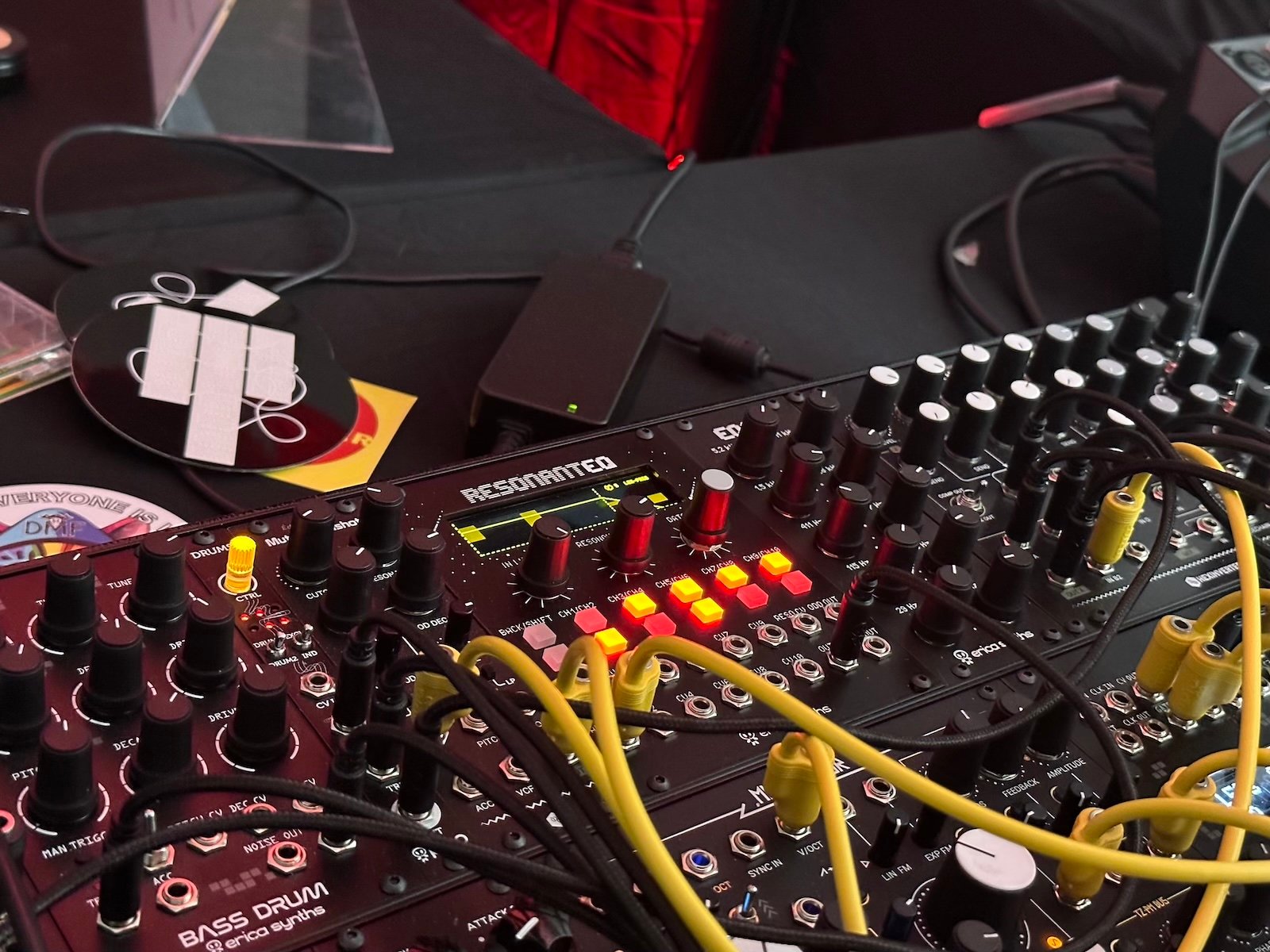
Erica Synths has announced the newest addition to their extensive Eurorack collection. Meet the Erica Synths Graphic Resonant EQ, a 10-bank analog resonant EQ equipped with the flexibility of digital control. Each of the 10 bands can be controlled using dedicated buttons or CV. Digital control paves the way for resonant loops, clocked modulation, presets, a spectrum analyzer mode, and even multiple conventional filter modes, including lowpass, highpass, bandpass (with adjustable bandwidth), and notch.
The 20HP module displays bank settings on a rectangular screen, with resonance, data, and level knobs and dedicated bank buttons laying just beneath, and below those are the 16 CV inputs. And an optional expander is coming for those who want more hands-on control of each band.
The Graphic Resonant EQ has been in development for a long time—and as such, it is highly anticipated. If all goes as planned, orders will be opening soon!
Erica Synths Nightverb
Erica Synths isn’t slowing down their production of unique desktop gear. Packaged in the same stylishly sinister form as their Zen Delay and desktop synths is the newly-announced Nightverb, an extremely playable reverb stereo effects unit developed in collaboration with 112dB.
Despite its name, Nightverb isn’t the darkest reverb, with demos revealing a high-fidelity sound, powered by a custom algorithm specialized in preserving high frequencies for extended periods. When paired with the freeze function, this creates a very playable unit controllable via the size knob and with midi. And just like Erica Synth’s Zen Delay, the Nightverb’s panel begs for constant interaction and live manipulation.
Front and center is an incredibly inviting Size knob that, according to the manual, emulates everything from the instant reflections of a tiny box to the soundscapes that are beyond the means of any manmade structure. With features like midi control of every parameter and presets, Nightverb looks like an extremely fun effects unit.
Five12 Vector Sequencer MKII
The Five12 Vector Sequencer becomes even more capable with a big upgrade. With a processor that’s five times faster and three times the memory, this MKII iteration introduces some new tricks, including a second set of chance operations, gate, velocity, and ratchet lanes, plus double the preset storage. Lastly, an upgraded DAC brings two new pitch-compatible CV outputs.
The updated expander slims down to 8HP. All-in-all the pair now facilitates up to 12 simultaneous voices due to the new inputs on the Vector, and the expander’s velocity outputs are now pitch-compatible.
Orders for the new Vector Sequencer and expander are opening soon!
Frap Tools New Modules
Frap Tools is presenting not one, but three new modules: the recently-announced CGM Insert, 411 quad VCA, and Bagài analog sample and hold module. Let's take a quick look at each.
CGM Insert is a new addition to the Frap Tools Creative Mixer ecosystem, enabling the easy addition of stereo effects to your signal chain. Designed to be inserted in the summing bus between channels, groups, or master modules, it allows you to process mixes (or submixes!) with any stereo processors in your system. You also get access to a parallel circuit for use with ambient effects, dynamic processors, and more—allowing easy facilitation of parallel compression and other common mixing tricks. Ultimately, for a handful of specific processing scenarios, it adds a significant level of convenience to the CGM system.
Next up is the 411 Quad VCA, a compact VCA and mixing module great for processing and routing CV or audio signals. With a flexible I/O architecture with some truly clever signal normalling, it can easily facilitate the modulation of multiple signals by a smaller subset of control voltages, or independent modulation of many identical duplicated signals. Of course, fully independent operation of each VCA is also easily achieved: so, it's great for "typical" VCA duties as well as stereo VCA needs and more.
Finally, we arrive at Bagài, the most complex module of the bunch. It's billed as a sample and hold, but don't let that simple description fool you: as with any other Frap Tools design, it's packed with a surprising level of functionality sure to add to any system. It can do random voltage generation, clock bursts, audio downsampling, noise generation, variable bit-depth random voltage generation, smooth random voltage generation, and more.
As with any Frap Tools module, you can expect a high degree of patch-programmable possibilities—so if you're looking for a new tool for exploring randomness or multifaceted smooth and stepped modulation signals...or if you're looking for an audio destruction tool with variable sample rate and bit depth (sample rate reduction and bitcrushing ftw!)...we recommend that you take a close look.
All three modules are up for orders now!
Gamechanger Audio Plasma Voice
Gamechanger Audio is known for achieving unique results through novel engineering, and they’ve done it again with a new synthesizer Eurorack module: Plasma Voice. Borrowing some tricks from the Plasma Coil and Plasma Drive, Plasma Voice receives its essence from manipulating high-voltage electrical discharges in a xenon-filled gas tube. You can see the intense electrical arcs flashing when the Plasma Voice is in action. This high-voltage energy is converted into audio via the device’s specialized circuitry, giving the Plasma Voice its highly saturated character.
From there, proprietary digital control takes over to manipulate the sound via interaction with the device’s transformer and tube driver circuits. This digital control enables the Plasma Voice to achieve a wide variety of sounds. The module packs 49 different synthesis engines organized into seven categories: bass, lead, pluck, drum, metal, static, and spark, and each category gets seven sounds. While there’s a lot of variety, the character of the Plasma Voice is impossible to hide, producing thickly saturated rich tones that encourage hours of harmonic exploration.
Once a foundational timbre is selected, you can further sculpt and adjust your sound with the Plasma Voice’s analog drive, eq, amplifier, and filter. Further experimentation and integration with your rack and other gear await in a plentiful offering of CV inputs, as well as direct midi (trs) control.
Instrūo dàil
New from Instrūo, dàil is an answer for all sorts of questions related to pitch control in Eurorack modular synthesizers. Offering signal quantization, precision adding, MIDI to CV conversion, and USB MIDI host capabilities, it's a sure way to get you system playing reliably in tune—opening up realms of tonal exploration.
Quantization scale may be selected locally or via external MIDI data; the USB host port can accept and power class-compliant MIDI devices, making it simple to integrate modern MIDI controllers into your setup. MIDI programming of quantization values can be especially interesting and rewarding—indeed, you can use your MIDI keyboard to specify scales/note patterns—even patterns that span multiple octaves. Of course, MIDI isn't required to specify quantization patterns: you can also program dàil using front panel controls, either note by note or by altering many pre-set starting points.
The precision adder feature can be used to offset any incoming signal by a specific chromatic interval. You can transpose any signal with a high degree of accuracy, making it easy to generate continuously evolving pitch patterns, controlled octave shifts, and much more.
If you're looking for a compact way to take control of pitch in your modular system, dàil offers a surprisingly complete complement of tools for its size. MIDI to CV, precision adding, and quantization all combine to create an easy and fun way of exploring melody and harmony.
Jolin Avalith
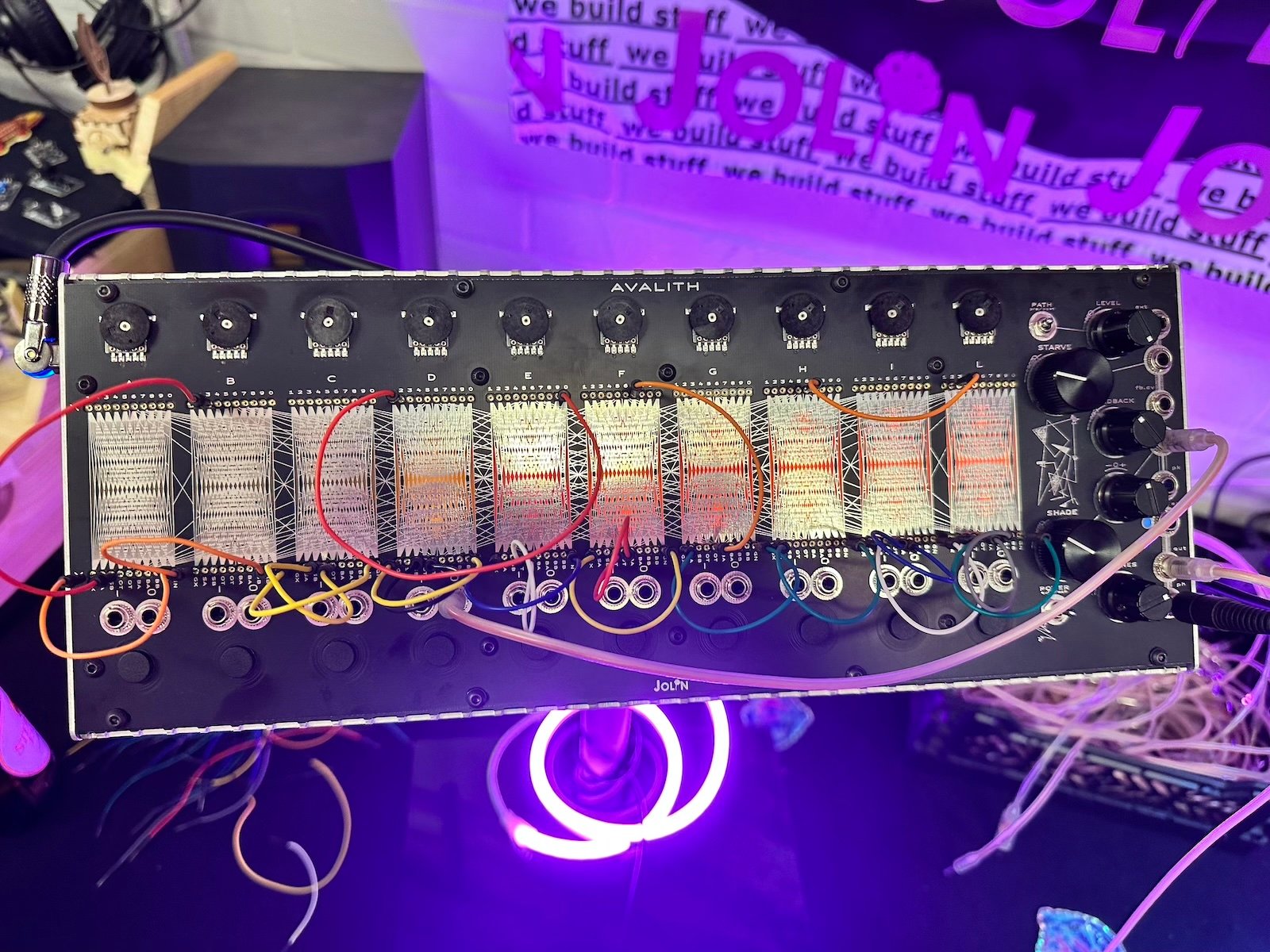
The crafty designers at Jolin heard you liked drone synthesizers, so with their new instrument Avalith, they've packed 100 oscillators inside for you to craft absolutely massive sonic statements!
All of the oscillators are grouped into banks of 10, with shared controls and inputs available for manipulation. Additionally, the included Dupont jumper cables can be used to access the core circuits of the transistor oscillators. In addition to the oscillators, Avalith also offers an onboard lowpass filter and envelope for shaping sounds further. With the vast range of sonic possibilities of 100 oscillators, these elements can all interact for massive detuned drones or gurgling pinged filter bleeps and bloops.
Avalith is designed to be equally at home within a Eurorack system, or completely standalone and travel with you on the go. The included aluminum case supports USB-C power delivery systems, making it compatible with power banks delivering up to 120W into Avalith. There's also a DC outlet for powering a small companion case alongside Avalith—perfect for effects processors, additional CV sources, and more. It's also VESA mountable for elevated usage, or removable from the case to be placed in a Eurorack system.
Avalith will be up for preorders soon!
Joranalogue Cycle 5
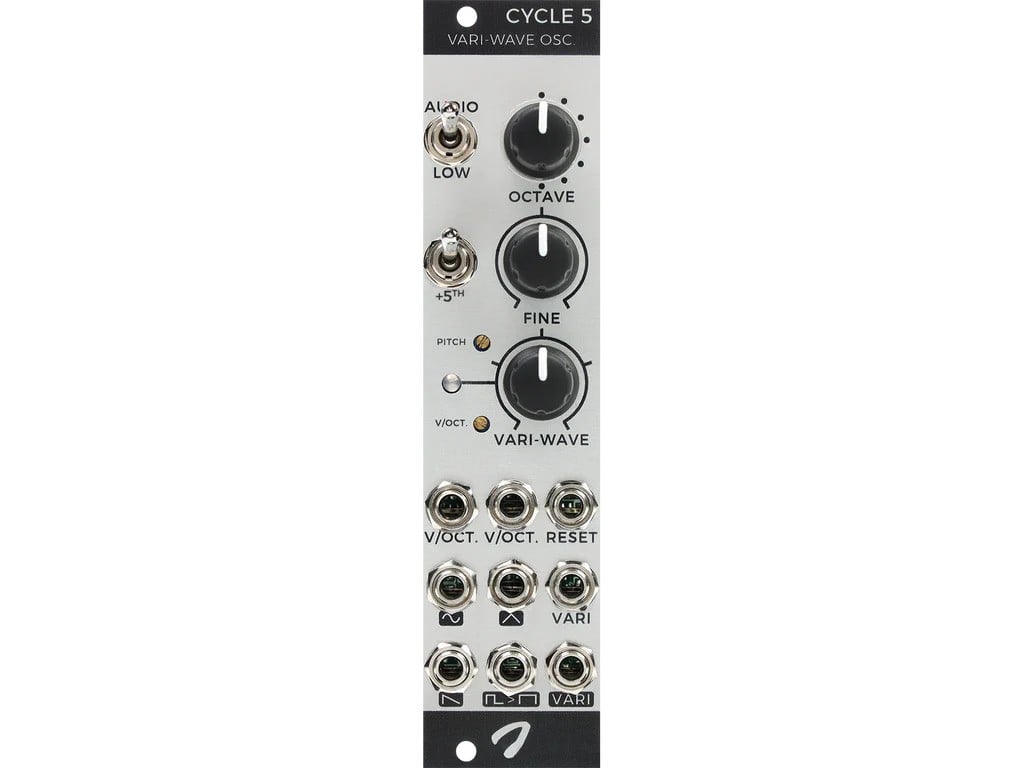
Many of today's flashiest Eurorack modules might be digital behemoths, but if there were anyone pushing the boundaries of analog circuit design, it would certainly be Joranalogue. Recent endeavors like Orbit 3 and Step 8 are shining examples of the precision and craftsmanship Joranalogue is putting into fully analog designs, with no sign of caving in and putting out a Jor-digital product anytime soon.
For Superbooth 2024, Joranalogue is introducing Cycle 5: a compact but surprisingly potent analog oscillator. At the center of this triangle-core oscillator is an incredibly refined stability circuit. As such, Cycle 5 features only a fine-tuning dial along with a 7-position octave switch—centering the fine tune control will always put the module to C! There's also a perfect 5th transposition switch, as well as dual precision-added 1V/Oct inputs for pitch control + exponential FM or interlocking sequencer control.
But how does it sound? Cycle 5 offers an array of classic subtractive synthesis waveforms: sine, triangle, saw, and square/pulse. There's also a very fun vari-wave output, morphing between all of the above waveforms with the manual control or via CV. Self-patching this or controlling it with another audio-rate oscillator (perhaps a second Cycle 5 for pitch stability?) can lead to delightfully harsh timbres. Of course, simply using an LFO or envelope to impart different degrees of timbral intensity is a tried and true approach, too!
Cycle 5 isn't available just yet, but Joranalogue is planning to begin shipping these in Q3 of 2024.
Knas: Ekdahl FAR
Truly an exciting new electro-acoustic instrument, the Knas Ekdahl FAR looks to be an innovative new approach to mechanically-controlled strings.
The Ekdahl FAR operates with a bowing wheel and controllable mute placed upon a string, and is able to produce a variety of timbres through overtone manipulation and muting techniques. Like strings on a guitar or violin, different amplitude envelopes and harmonics may be explored through different playing techniques. In this way, FAR has more in common with an acoustic instrument rather than a synthesizer.
But rather than manipulating the string yourself, Knas has devised a sophisticated control system that's compatible with MIDI, USB, or control voltage connections. A robust mapping language has been developed to gain the most possible control from the excitation and muting components. Of course, the instrument itself is designed to be extensible and customized, and the firmware will be open-source to encourage community contributions and enhancements.
That's all of our information for now, but expect the Ekdahl FAR to be available sometime in 2024.
KOMA + Passepartout Duo : Chromaplane
Teased for the first time about a month ago, KOMA Elektronik is in Berlin showing off their new Chromaplane, designed in collaboration electro-acoustic artists Passepartout Duo. The duo has a long history of using heirloom instruments in their artistic practice, and this new collaboration with KOMA seems to be right up their alley.
With its striking yet minimalist design, Chromaplane is an explorative instrument performed without touching it. Instead, the player wields one or more electromagnetic field microphones, waving them across nodes on the surface of the Chromaplane. Their proximity then excites the circuitry within the Chromaplane, which can be configured to produce a variety of tones or note interactions. The instrument is highly configurable, additionally featuring a lowpass filter, onboard delay effect, envelope followers, and more.
Beyond spending a few moments listening to it at the KOMA booth, a lot is expected to be finalized in the coming months. Stay tuned for more information about the Chromaplane later this year!
Korg.Berlin Acoustic Synthesis_phase8
Korg.Berlin is back at Superbooth this year, showing the latest version of their acoustic synthesis instrument: now named Acoustic Synthesis_phase8. You might remember the prior version, Phase5, from last year's Superbooth—and you might recall our visit to Korg.Berlin headquarters to talk to CEO Tatsuya Takahashi about phase5 and Korg.Berlin's mission in general (check out the full interview here!). So. what exactly is Acoustic Synthesis?
Korg.Berlin has been exploring an altogether new approach to synthesis, focused on the electronic/electrical excitation of physical metallic resonators. So, in a sense, it's a hybrid of acoustic and electronic sound production—and as such, it comes with its own new internal logic and approach to both sculpting sound and making music. Using focused magnetized vibration of fork-shaped resonators, it can produce all manner of sounds from harmonic/melodic to rhythmic and beyond.
The currently-presented phase8 is a considerably more compact and refined-looking approach to this instrument concept. It features eight electromechanical voices, built-in polyrhythmic sequencing, waveshaping, envelope control, swappable resonators, and much more.
At this point in time, Acoustic Synthesis_phase8 is still a concept/prototype—but Korg.Berlin hopes to return to Superbooth in 2025 to show their first acoustic synthesis products. We'll have our eyes and ears open!
KORG PS-3300 FS
Korg continues their artful recreation of legendary synthesizers with a reissue of the monumental PS-3300FS. An extremely rare and coveted wonder machine of the late 70s and early 80s, the PS-3300FS is as beastly as it gets with 49-voice polyphony, three PS-3100 synth layers, multiple filters and envelopes, and a three-band resonator.
Though the reissue will be 100% faithful to the original where it counts, there will be some modern quality-of-life improvements. New panel memory will store 256 programs, and connectivity will include USB and MIDI. There will also be a software librarian app.
Multiple statements from Korg assert these extravagant deep dives into the greatest machines of synthesizer history come from a perspective of true appreciation.
“Bringing back to life these legendary machines is not only a process of reproducing circuits and sounds, but also of learning and embracing the essence of the philosophy and development of synthesizers.” — Yoshihito Yamada, Chief Engineer of Korg Analogue Synthesizers
PS-3300FS is, regrettably, still not available for orders—though we've heard that preorders should be opening soon.
Landscape Ferrous
New from Landscape in conjunction with sound artist evicshen (Victoria Shen): it's Ferrous, and you just might never need an eBow again. Described as a spinning magnetic string resonator, the Ferrous is meant to be paired with steel-stringed instruments. The rotation of a spinning disc containing six strong earth magnets causes steel strings to resonate, with slow speeds having more influence on thicker bass strings and faster speeds more prominently affecting the thinner high strings.
The player controls the disc’s spin rate using a thumb wheel, “rev” button, and touch plate; you can also use incoming CV. By fluctuating the spin rate, the height of the Ferrous relative to the strings, and proximity to any pickups, a range of dynamics can be added to the performance.
But what does it sound like? Being a resonator with almost exclusively organic control methods, the Ferrous is right at home eliciting earthy drones and beautifully unstable pads via subtle movements. However, holding the magnetics near pickups seems to easily create heavier sounds; when paired with volume and distance variation, the rate of timbre change can happen suddenly, if desired.
The Ferrous seems a musical tool that will reward exploration, nuance, and finesse.
Love Synthesizers First Love
FM synthesis is often overlooked due to fears of its complexity and learning curve. Love Synthesizers is taking a shot at dispelling those fears with an approachable synth in a compact and undeniably lovable form factor. Aside from a cute Gameboy-esque frame, the first thing you notice about the First Love is a gorgeous 7-inch touchscreen that communicates beautifully animated representations of what’s happening under the hood.
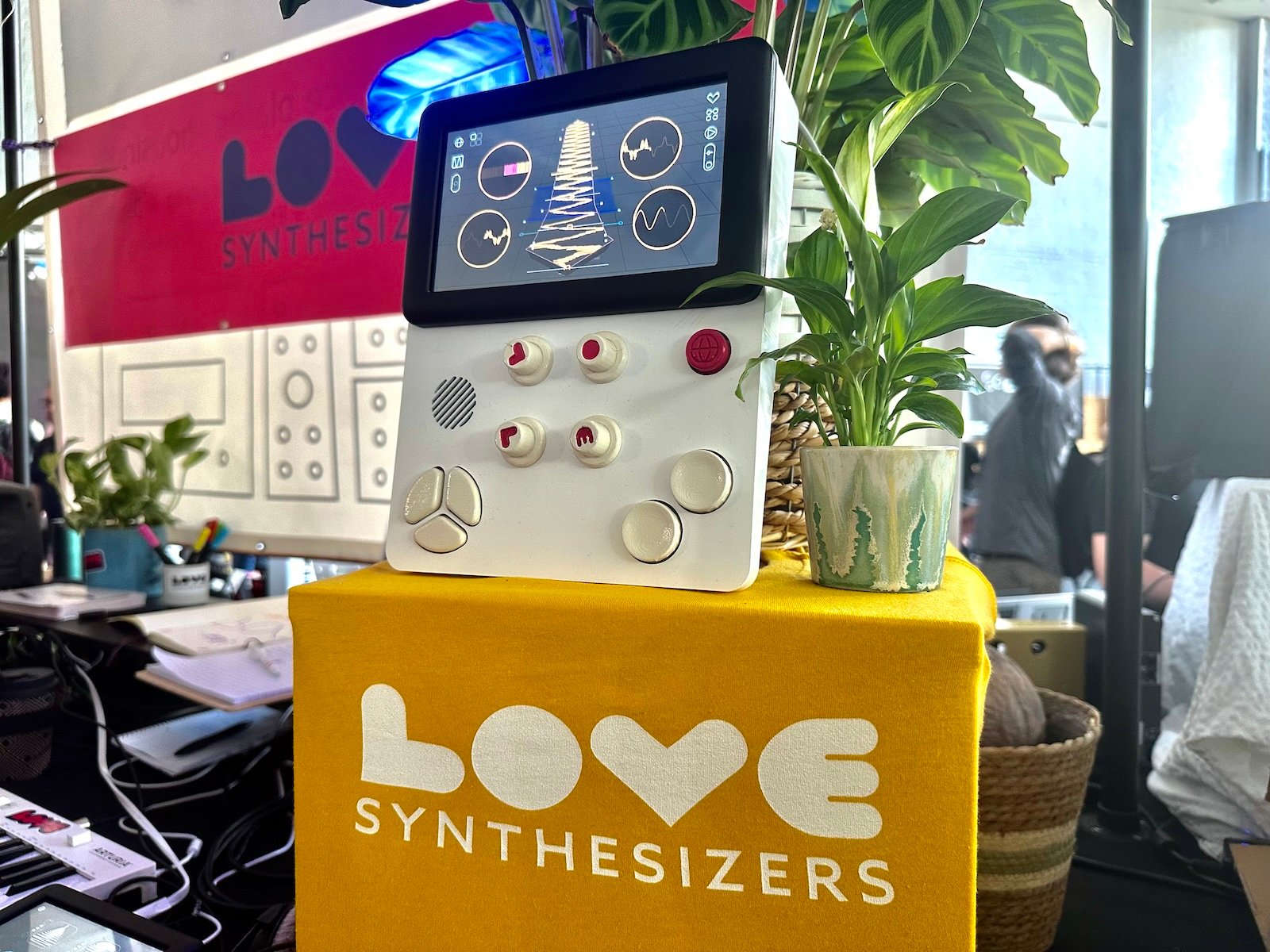
Details are light at the moment, but the essence of the First Love appears to be in its four simultaneous FM synth engines. Rumors are that each engine will build timbres with 4 FM operators, user-definable algorithms, and even an added sine wave with wavefolding for increased timbral range. It’s likely that a big part of First Love’s sound will involve morphing between and stacking these timbres. Love Synthesizers appears dedicated to bringing the intricacies of FM synthesis into the means of mere mortals with a fast and user-friendly workflow.
Melbourne Instruments Delia
A surprise release from the makers of Nina, Melbourne Instruments has brought the new Delia keyboard synthesizer to Superbooth 2024. In some ways, it's a slightly slimmed-down version of Nina, but in other ways, it expands on the possibilities—and of course, it features their super cool motorized knobs.
Motorized knobs, you say? Yes! Melbourne Instruments has refined what they call Rotary Recall technology, featured in Nina and now Delia. Historically, the problem with preset recall, multiple parameter pages, and the like is that the positions of knobs no longer match the current settings. Certain solutions like endless encoders or LED rings can alleviate this problem to an extent, but often you deal with issues in resolution or how to handle interpolating to the new setting if you touch the knob.
But on Delia, you can easily repurpose one knob for multiple purposes thanks to the internal motor controlling its position. Preset recall can be instant or interpolated, with the knobs moving immediately in real-time. Other functions like parameter pages for LFOs or envelope generators are handled in a similar fashion, but perhaps the most fun thing is switching a tuning knob between coarse and fine-tuning modes. Haptic feedback simulates the sensation of using a stepped adjustment knob, but in fine mode the knob returns to being as smooth as can be.
Officially speaking, Delia is a six-voice, bi-timbral hybrid keyboard synthesizer. Digital oscillators covering a range of virtual analog and wavetable sounds paired with analog lowpass filtering and VCAs ensure that Delia leans into the strengths of its signal architecture. Interestingly, there is a mode that allows Delia to achieve the 12-note polyphony of Nina—routing two notes through each of the six filter-voice stages. There are also new digital highpass filters ahead of the analog lowpass section, with the ability to link them together for bandpass or notch operation.
Additional features like the (obviously) added 49-note keyboard, an expanded modulation matrix, new overdrive options, and several other refinements make Delia stand out from its predecessor. It's also poised at a comparatively more affordable price thanks to the slightly reduced voice count and fewer motorized elements. Cutting edge in both sound and function, we're sure Delia is going to be a serious contender for anyone seeking a well-rounded performance synthesizer.
Delia is available for preorder right now!
Meng Qi + Whimsical Raps Horizon
A long-awaited collaboration between two of the more adventurous instrument designers out there is finally seeing the light of day at Superbooth 2024. Horizon, designed by Meng Qi and Whimsical Raps, maker of the beloved Mannequins Eurorack modules, is a one-of-a-kind explorative synthesizer with unmatched sound and aesthetics.
Horizon holds roots in past Meng Qi designs, notably the Wing Pinger, but extends well into its own unique territories. Namely, the similarities are held in the pinged filter sound sources with just intonated melodic tendencies. However, across the interlaced touch surface a variety of chaotic feedback loops and interferences may be discovered, rerouting signals from control voltage generators and across internal stereo audio delays. And of course, the delightful colors and choice of knob and slider caps give it an appearance less of a cold machine but an inviting canvas for exploration.
Horizon isn't available just yet, but it's expected to be out later this year.
Modbap Modular CLRS
Modap mixes the DNA of their Hue module with a stereo signal path, a more advanced filter, and a larger scope of sound coloring options and settings to produce a deep and versatile sound shaping and coloring module: CLRS, the newest addition to their Eurorack lineup.
Stereo inputs lead into a redesigned DJ-style dual filter controlled by a single inviting knob. By adjusting the knob between left for lowpass and right for highpass, you can find the frequency foundations before moving on to all manners of signal degradation goodness.
First comes the versatile Drive effect, enabling the crushing of your sound with powerful distortion or a light crisp of tasteful saturation, and everything in between. An accompanying Width knob provides control over the stereo spread. Next, emulate the characterful nostalgia of yesteryear with a sample rate decreasing Lofi knob, channeling the familiar sounds of classic gear.
If you’re still craving more destructive character, use the Bit Depth knob to get bitcrushed sounds, emulating older digital signal paths and audio formats. Follow that up with the more subtle Mag knob to add the magnetic effect of tape saturation, allowing you to dial in just the right amount of vintage into your sound. At the end of the signal path, a one-knob compressor with three different ratio settings brings that final touch of dynamic balance. The compressor also has a duck input for sidechain control. Finally, to go deeper, further integrate the CLRS into your modular patches with CV control inputs for the filter, Drive, Mag, and Lofi effects.
CLRS is available for preorder now!
Moog Spectravox
Moog has announced the newest member of their semi-modular synthesizer family: and it's Spectravox, an analog semi-modular spectral processor. It's part synth, part vocoder, and part peculiar filtering tool for external devices. So, what is Spectravox all about?
Spectravox's main feature is a ten-band variable filter bank. The filter bank is comprised of ten filters: one low pass, eight band pass, and one high pass filter. Each of these filters features a dedicated volume control (each with accompanying CV input). The entire filter bank features a macro resonance control and "Shift" control—which allows you to alter the cutoff frequency of all filters simultaneously. The relative spacing of the individual bands remains the same...but you can effectively "sweep" the entire bank up and down over the full audible frequency range. So, while most filter banks out there have a fixed frequency response, Spectravox doesn't—opening it up to a huge range of sonic possibilities that we haven't seen before in commercially-produced gear.
For instance, Spectravox can be a powerful formant filter, for either its internal sound generators or external signals. It has enough resonance to be pinged—allowing you to produce all sorts of physical modeling-like tones, watery plops, and more. And—making internal use of the per-band envelope followers—you can even use it as a ten-band vocoder.
That's right, you can use an external program input to treat Spectravox like a vocoder. Simply plug into the front-panel combo XLR-1/4" input for external mics or line-level sources; or use the patch bay's 3.5mm program input for modular-level signal sources. This allows you to impress the spectral content of the incoming sound on Spectravox's own internal oscillator and noise source...great for robotic vocal sounds with an external mic, rhythmic filtering when used in conjunction with drum machines, and much more.
Of course, you can also use an external carrier signal. In filter bank mode, that means that you can use Spectravox's filter to process any sound you like. In vocoder mode, it means that you can use any sound source as the carrier for vocoding: you could create drum machine patterns with the inflection of human speech; you could apply the spectrum of a field recording to the sound of a synthesizer: it's all up to you.
Spectravox's potential uses are vast—it adds a ton not only to Moog's own lineup, but to the world of semi-modular synthesizers as a whole. To dive deeper into the details, check out our dedicated Spectravox review article.
Oberheim TEO-5
Oberheim presents TEO-5, a 5-voice polyphonic analog synthesizer that offers the best of Oberheim's classic designs in a compact and powerful keyboard. Breaking into new territory for the legendary synth company, TEO-5 provides the classic analog sound of SEM oscillators and filters, plus through-zero FM, and faithfully-recreated models of Oberheim's phase shifter and ring modulator. So, yep, it's an Oberheim through-and-through: from sound generation and filtering all the way to the processing elements. Borrowing Tom's own initials, this synth is the true culmination of Oberheim's legacy, offering a potent pairing of vintage analog tone with modern features—at the lowest price of any Oberheim instrument to date.
The raw tone of analog VCOs and filters are the heart of TEO-5: offering the warmth and punch you'd expect from any Oberheim. Triangle, saw, and variable pulse waves give you plenty of timbral options, while the state-variable SEM filter delivers loads of sculpting potential. Thru-zero X-mod FM adds even further sonic interest, with an adjustable mod amount that helps you dial in the exact amount of FM from clean metallic tones to biting FM percussion. It'll make wild bell tones, gnarly growls, and plenty more. Turn up the Vintage knob for voice-to-voice variations—emulating the instability of vintage electronics. Dedicated reverb, multi-effect, and overdrive effects round out the instrument.
TEO-5 also sports a battery of flexible modulation and performance controls. The Fatar keybed tracks velocity and channel aftertouch for expressive playing, while a 64-step polyphonic sequencer and multimode arpeggiator animate your rhythms and harmonies. Two velocity-sensitive DADSR envelope generators and two tempo-syncable LFOs route to many destinations for even greater timbral evolution.
It has 256 factory programs and 256 user slots—so it's ready to inspire and ready to capture your sonic explorations. If you need a compact touring keyboard, if you're looking for your first synth, or if you're trying to add the sound of an Oberheim to your setup—this instrument is an amazing value. It's up for orders now!
Ohm Force Ohmicide (Eurorack)
Ohm Force brings their renowned distortion plugin out of the box and unleashes all of its 111 distortions into the world Eurorack with the new Ohmicide module. The stereo Ohmicide comes with 37 types of distortion, each with three variants. Bias and mod knobs invite exploration producing different results on different distortion types.
Ohm Force has also included a thorough set of taming and shaping tools. A Xover knob helps preserve bass by splitting the Ohmicide’s stereo signal into two frequency bands, leaving the lower band unaffected. You also have pre and post-distortion low pass filters for flexible sculpting. If you’re looking for a module to crunch, crush, or saturate your modular sounds, you’d be hard-pressed to find one with more variety than the Ohmicide.
Orders are opening soon!
OXI Instruments Meta
Our friends from OXI instruments are back at Superbooth. Naturally, they're showing their extant products, the ever-so-wonderful Coral (a polyphonic, multi-timbral, multi-part sound source) and One (a remarkably powerful MIDI and CV controller).
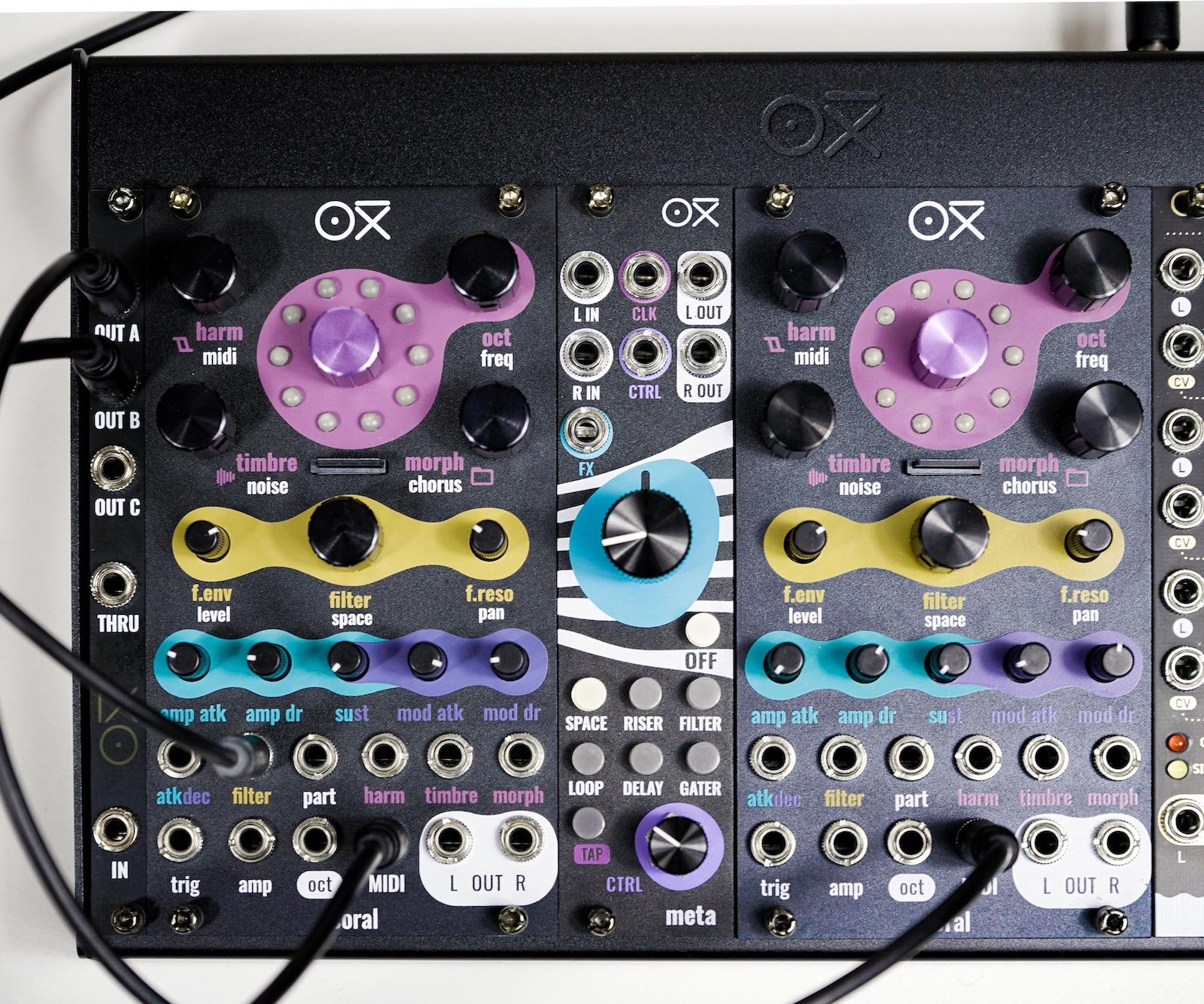
But they're also showing something new: Meta. Meta is a stereo end-of-chain effects processor for your Eurorack system, designed with a highly performative user interface. In essence, Meta provides multi-effects with a variety of easily-accessible effect "scenes." The six scenes are titled SPACE, RISER, FILTER, LOOP, DELAY, and GATER. These scenes can be arbitrarily accessed quite quickly—making Meta a great tool for turn-on-a-dime effect-based transitions, momentary tension, and much more. Full details about Meta's functionality are still forthcoming, but we anticipate it will prove especially useful for musicians working in dance genres where performative effects are commonly used as articulators of musical structure. Meta is still in development—it may be out later this year.
OXI is also showing a new colorway for their module Coral, as well as a 2hp Eurorack-format version of their MIDI splitter, the aptly-named Split. One thing's for sure—OXI is going to keep making amazing instruments, and we're excited to see what they get up to next.
Patching Panda Etna
No strangers to designing analog filters with unique digital control schemes, Patching Panda is presenting their latest module at Superbooth 2024: Etna.
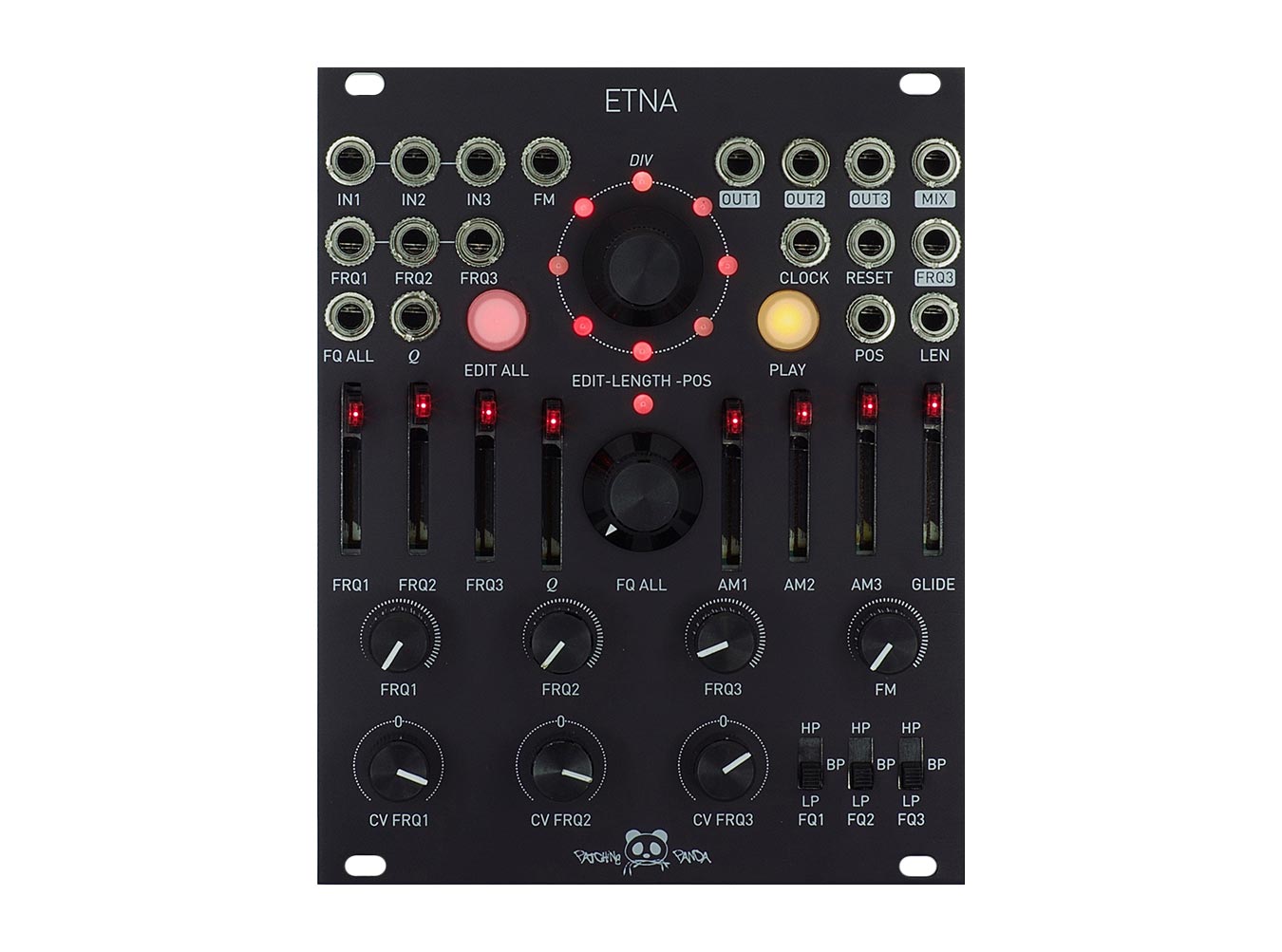
Inside of Etna are three analog filtering stages, managed by both analog and digital control schemes. Each filter, which can be set to operate as lowpass, bandpass, or highpass, has both a frequency knob controlling its cutoff in real time as well as a slider corresponding to a snapshot state. These snapshots, which are indicated and selected by the LED-encircled encoder at the top, allow you to recall and sequence different states in time with your patch.
Snapshots allow you to assign frequency and amplitude settings for each of the filters, leading to dynamic and exciting timbral sequences that can evolve with your patch. Etna also features a glide parameter, which allows you to dial in hard steps between stages or smoother transitions. Edit mode makes it possible to adjust specific stages while snapshots are playing back, and the aptly-named Edit All option applies changes to all snapshots at once for continuity where it counts.
Etna is gearing up for release soon—expect it to be available in early summer 2024!
Pittsburgh Modular Voltage Lab 2
Pittsburgh Modular has announced Voltage Lab 2: the newest iteration of their cult classic modular system, 2019's Voltage Research Laboratory. But it's more than a mere reissue: Voltage Lab 2 is a bafflingly complete complement of modular synthesis tools. Indeed, it's Pittsburgh's most complete and thoroughly thought-out instrument to date: and we're confident that in time, it will prove to be one of the most interesting electronic instruments of our current era.
In a world where many modular manufacturers are slowly venturing into standalone instrument design with compact desktop units, Voltage Lab 2 presents a refreshing alternative: it's a full-size, deep, no-compromises instrument. Coming in at a full 2x 90HP (and shipped in its own self-contained enclosure), Voltage Lab 2 embodies a bold design ideal: while modular synthesis for many is about putting together your own piecemeal system comprised of individual discrete modules, Voltage Lab 2 instead presents a fixed complement of tools: and, by extension, it proposes that perhaps there is more to modular synthesis than the all-too-common "gotta catch 'em all" that sometimes comes along with the Eurorack format. Indeed, Voltage Lab 2 is a complete instrument with its own rich internal ways of thinking about musical organization. Happily, it is still fully compatible with external voltage-controllable devices, and can easily interface with your Eurorack or semi-modular gear; however, at the same time, it presents a musical universe all its own. So, if you're looking to dive into modular synthesis without the trial and error of piecing together your own system, the Voltage Lab 2 is a brilliantly curated complement of tools that will keep you busy learning, discovering, exploring, and researching for years to come.
So, what exactly is in Voltage Lab 2? We're glad you asked. Voltage Lab 2 is composed of two modules: the Voltage Lab 2 voice module and Touch Controller 2, a keyboard/sequencer designed to facilitate intuitive, yet complex performative interactions. The instrument as a whole has some clear influences from the infamous instrument designs of Don Buchla—but despite that, it has a distinct sonic and functional identity.
The star of the Voltage Lab 2 module are its two Laboratory Oscillators—each presenting its own approach to continuously variable waveshaping. The first oscillator includes a mind-melting wavefolder (capable of folding even the "unfoldable" saw, and pulse shapes), as well as Pittsburgh's unique center clipping technology, which allows independent control of the amplitude of the positive and negative portions of the waveform prior to the folding stage. This allows a huge range of timbral variety. The second oscillator features two other interesting concepts: a reflection circuit, which you can think of like a continuously variable rectifier—and a "pulse symmetry" control, which gives you extended control of the stairstep-like pulse wave. Together—with additional options for inter-oscillator bidirectional sync, ring modulation, and analog sample rate reuduction—these oscillators present a huge range of timbres for creating the basic structure of your sound. This module also includes two Dynamics Controllers—Pittsburgh's unique take on the lowpass gate concept—as well as Florist (an analog flanger/chorus/pseudo-reverberator) and Echos (an analog delay).
In terms of modulation, Voltage Lab 2 offers a Chance Sequencer (a type of random voltage/gate generator), a sample and hold, two looping function generators with a wide variety of inputs and outputs, and plenty of voltage processing onboard. Additionally, it contains a MIDI to CV converter. Though there are a small number of normalled internal signal connections on Voltage Lab 2, most signal connections are established purely through the use of patch cables: it doesn't impose a specific signal flow on the user, instead favoring an open-ended approach to both the sound structure and control paths.
Touch Controller 2 is a feature-packed touch keyboard/sequencer akin to Serge's TKB, Buchla's Thunder, and other devices of the past. It couples a capacitive touch surface with robust sequencing facilities; and, while it might resemble the TKB or its many Eurorack derivatives, Touch Controller 2 presents its own unique take on touch sequencing. It features two primary channels, Red and Yellow, each of which have their own full set of inputs and outputs. Each of these channels can function completely independently: one could act as a sequencer while the other acts as a keyboard; each could respond to the keyboard differently; each could act as a sequencer simultaneously, running at different rates/with different step lengths/etc. Additionally, the sequencer has advanced features like ratcheting, step probability, and various types of algorithmic/conditional response. So, while it's certainly easy to use the Touch Controller as a typical CV keyboard or sequencer, it's much more than just that: think of it as a way of gesturally interacting with complex processes, capable of turning simple interactions into something kaleidoscopic and ever-evolving. Oh, and it even has MIDI I/O!
Voltage Lab 2 is a deep instrument: I'd recommend checking out our full review for greater detail and more perspectives on its philosophy and inner workings.
Polyend Tracker+
Polyend has updated their infamous sampling workstation: introducing Tracker+, with more tracks, all-new internal synthesis engines(!!), and expanded sampling capabilities. Like the original, the Tracker+ is a hardware-format take on the sequencing workflows in "tracker" software such as LSDJ, Renoise, and others. Unlike your usual step sequencers or piano roll arrangements, Tracker+ excels at composing intricate music with a level of detail that is find in other sequencing paradigms. That said, it's a perfect entry-point into this style of music-making, with a well-thought-out interface and workflow that makes the most of its esoteric sequencing logic.
Tracker+ features 16 tracks—eight more than the previous model. These tracks may act as MIDI tracks for sequencing external instruments, or make use of the Tracker+'s all-new internal synthesizer engines. These are a huge development—as you no longer need to use samples alone as the basis for your compositions. The ACD, FAT, VAP, and WTFM engines offer a huge range of classic and all-new synthesizer tones, and when combined with samples from other tracks, you'll have plenty of room for exploration. Additionally, a new PERC Drum Machine engine gives you classic 808 and 909-like sounds, while also venturing into newer percussive tones as well.
While sampling is still a key feature, the Tracker+ boasts some welcome updates. Like the Tracker Mini, Tracker+ supports stereo sampling, and all sampler engines have been updated with full stereo support. One-shot and Reverse playback, slicing, granulation, and wavetable possibilities—any and all sounds are up for creative transformation. The built-in FM radio (yep!) also allows you to capture unexpected sources in the absence of other sound sources.
Each Tracker+ project includes 16 tracks, with up to 128 steps within each sequencer. You can modify track parameters across patterns—with 256 patterns available per song. This means that you can chain and compose highly structured tracks with a huge degree of freedom. Patterns can be manipulated with several fill modes, with algorithms such as Random, Euclidean, Musical Scale quantization, and more. Plus, a dedicated live performance mode lets you create FX assignments and tweak parameters in real time.
With a crystal-clear 7" display and 48 multi-purpose pads, you have ample visual feedback and performative control. You get more internal storage, USB connectivity, multitrack audio via USB (!!!), and many more quality of life improvements. Back and better than ever, Tracker+ offers a refreshed and impressively deep approach to music composition.
RYK Modular ALGO
RYK Modular's recently-announced ALGO is an accessible Eurorack FM synth engine that somehow manages to dispel the typical exhaustive FM menus with nothing but a simple path of LED lights. Representing another step in the general forge toward accessible approaches to FM synthesis, ALGO is fun, powerful, and capable of a huge variety of lively FM tones difficult to achieve with other interfaces.
This 4-operator FM synth engine intuitively communicates the selected FM algorithm by visually connecting modulating oscillators to carrier oscillators with paths of colored LEDs. This simple visual interpretation is so effective at displaying the FM algorithms that you can’t help but wonder why we’re just seeing this easy-peasy interpretation in 2024. You'll be whipping up all sorts of complex and engaging FM tones in no time—so if you've ever struggled with a Yamaha DX synth, don't fret…ALGO's UX design is second to none, revealing completely new ways of engaging with this familiar (yet famously frustrating) approach to synthesis.
Though ALGOs intuitive interface is centerstage, the offerings don’t end there. A wave warping knob holds bundles of timbral possibilities as it can be applied to both carriers and modulators. Additionally, you have three flavors of wavefolding, a detune spread, and a stereo chorus to add to the additive audio party.
If you're looking for a new, fun, and inuitive way to approach FM, this just might be the module for you.
Schlappi Nibbler + BTMX + BTFLD
A few months ago, Schalppi Engineering unveiled Nibbler, a four-bit playground for exploring the musical fun of binary and shift registers. In a short time, its become a highly-regarded source of unique and quirky sequencing, finding a home with adventurous patchers seeking a delicate balance between predictable and generative results. Little did we know that at Superbooth 2024, Schlappi would come to Berlin with even more designs to build upon what they're now calling their Logic Subsystem.
BTMX, also known as BitMix, is one such module. As a malleable logic utility, BTMX offers four channels with two inputs each, and can be programmed to use a variety of different logic functions to produce a corresponding outputs. AND, OR, ADD, and XOR will combine or reject input signals in different ways, putting a variety of fun gate generation opportunities at your fingers. And we mean this literally, as not only does BTMX have CV inputs but also manual buttons at the top. For extra utility, a stepped CV output produces a 4-bit (16 possible values) signal based on the state of the four channels.
Leaning just a bit (pun intended) more on the bizarre side of things, the upcoming BTFLD (Bit Fold) is a hybrid wavefolder and analog-digital converter. Featuring a number of simultaneous outputs, BTFLD is adept with both audio and control rate signals. A unique sawtooth wavefolder leads to timbres less in the realm of Buchla-tradition and more crusty hard sync-like sounds. The stepped output covers bit crush effects, while its components are broken out into individual square wave outputs. These represent frequency multiplications of the input—distortions at audio rates and rhythms at LFO rates.
Alongside these, a number of prototype and conceptual modules are on display to offer a general idea of what a full Schlappi system might look like someday. One module that's a bit further along in development is the Dual Vector Foil, a six-input mixer with window comparators, rectification stages, and a number of other options that are handy for processing control voltages.
Schlappi is planning to begin the rollout of these new modules in Summer 2024 and extending into the fall.
Shakmat: New Modules
Shakmat Modular returns to Superbooth this year—and they bring with them three new designs: Bishop's Miscellany MK2, Ballista Blast, and Griffin's Claws. These new devices bring welcome updates to old design concepts and all-new approaches, period...and we're sure they'll find a home in many a Eurorack system. Shakmat were kind enough to offer us video overviews of all the new modules—so let's take a brief look at each.
The name "Bishop's Miscellany" certainly harkens back to Shakmat's first module...but the MK2 is much more than a simple refresh of the original. The basic concept is the same—it's a module designed to make sequence-like modulation and timing easy, intuitive, and dang near instantaneous to generate. Using a dual stepped CV/gate engine, you can get two simultaneous sequences—great for driving multiple voices in your system.
While the original Bishop's Miscellany was primary a CV/Gate recorder, the new version is much more: it features a variety of methods for instantaneous sequence generation and, as Shakmat says, regeneration. It includes a sequence processor with glide, ratcheting, CV modulation, and gate length control—all of which can be motion recorded for dynamic, ever-changing sequences. But it also features internal quantization, pattern arrangement, and a wide range of internal algorithms for constructing and altering sequences programmatically, making it a powerful tool for live variation and performative evolution. Plus, with the ability to store recorded sequences on an SD card, it will be easy to get back to that perfect sequence once it has emerged. Additionally—as with the other two modules we'll explore—Bishop's Miscellany MK2 supports the Select Bus protocol, making it compatible with the growing selection of Eurorack modules capable of inter-module control and preset recall.
Ballista Blast is a hybrid digital/analog synth voice offering multiple synthesis engines. Sound generation and internal modulation are digital—but the internal filters, lowpass gate, VCA, and distortion are all analog. Ultimately, it produces a huge range of tones, including vintage analog-style sounds, swirling wavetables, and 4-operator FM with plenty of options for user customization.
The first engine (Classic) combines saw and square waves in various configurations, which pass to two analog filters, each with their own sonic flavor. You can do unison, sync, PWM, and more—the filters include a state variable filter and a four-pole ladder filter for a variety of sound sculpting tones. The signal then passes to a VCA and distortion. The second engine is a Wavetable engine, which offers a vast selection of tables, with the option for user customization. The Wavetable oscillator is passed through the same analog processing chain as on the Classic engine. Finally, the third engine is designed for FM: offering original FM algorithms processed by an analog LPG and VCA. Ballista Blast's FM algorithms feature up to four operators each, governed by three macro controls on the panel.
Ballista Blast includes a built-in envelope, random generator, and a "velocity" input, all of which can be assigned to most any logical parameter in the currently selected synthesis engine. As with the other releases, it supports preset storage for up to 100 groups of settings, which may be addressed using the Select Bus protocol.
Last but not least, Shakmat is showing Griffin's Claws—an attenuation recorder. While attenuators are no doubt a critical part of any modular system, they're not necessasrily the most exciting...but with Griffin's Claws, Shakmat shows that, with some creativity applied, even these simple utilities can become inspiring sources of performative control. Using four attenuators with motion recording and offset normalization, Griffin's Claws turns simple voltage processing into expressive performative control. Use it to process individual modulation signals, audio signals, or even use it as a mixer with motion recording—no doubt, you'll find many new ways to engage with your Eurorack system.
As with Bishop's Miscellany MK2 and Ballista Blast, Griffin's Claws offers preset storage, with its preset memory addressable via the Select Bus protocol. This means that your attenuation animation can be retrieved for future projects or performances.
These modules aren't available for orders quite yet—but we're eager to try them out for ourselves. These basic descriptions have barely scratched the surface of what these modules can do, and we're excited to see what new possibilities they will offer.
SOMA Laboratory Flux
Flux is a new contactless instrument from the innovative mind of Soma Laboratory founder, Vlad Kreimer. At first glance, Flux behaves somewhat like a Theremin, but fairly quickly into any performance, it becomes clear Flux is much more than a modern take on the now century-old electronic instrument. Through exceedingly clever innovation, the Flux captures an unprecedented amount of gestural information, giving the player control of many parameters beyond volume and pitch.
Flux’s classy minimalist wooden enclosure contains a long row of sensors organized into a representation of a keyboard, though it looks more like a fretboard. The player holds a magnet between their fingers in each hand, hovering their right hand over the sensor “keyboard” to control pitch, volume, and dynamics while adjusting timbral parameters with the left hand over another set of sensors. The sensor keyboard with fixed tuning makes precise pitch playing much more accessible than it is on the theremin, as the player has a plain visual cue of where to find each note—pitch qunatization adjustment allows for everything from pure glides to precise note steps. And the Flux’s sensors detect more than proximity; as tilt, angle, and polarity also have an effect on the sound, facilitating highly organic, yet timbrally complex performances as we’ve seen with other Soma instruments like the Terra.
Also similar to Terra, Flux’s novel play method controls a variety of digital synth engines. You can’t edit most of the parameters of these engines, but that’s because they are incredibly nuanced, each having a clear place in the musical spectrum while maintaining an original voice. Vlad isn’t a fan of reproducing known sounds, as with his control designs, he seeks to break ground when sound crafting. As such, countless subtleties go into each engine, the control of which would require an extremely complex interface, and that goes against Vlad’s ambitions of getting players to focus on playing over programming.
Flux's sound ranges from ethereal gliding siren songs to cinematic basses to punchy distorted pulses with pleasingly chaotic shifts. Duophonic playing is possible using both hands over the pitch sensors, as are drone-like performances utilizing long release times. Last, but not least, the Flux will be able to act as a MIDI and MPE controller external synths and modular systems via a separately purchased breakout box with MIDI and CV connections.
Flux isn't available quite yet—but we're told that it should be open for orders this fall.
SOMA Laboratory simplexFM
Flux wasn't SOMA's only new instrument on display this year. In what may be a world first, SOMA is turning a piece of MIDI utility hardware into a synth via a free firmware update. The Metaconformer firmware update transforms SOMA’s simplexFM smart MIDI router into a 4-track organismic synthesizer.
While not exactly conventionally polyphonic, the new Metaconformer synth is multi-timbral, with each track having its own timbre. Selectable timbres include basses, leads, pads, noise, and more. Each track will also have a waveshaping oscillator, wavefolder, overdrive, and comb filter.
Like all SOMA creations, expect a strong nudge towards experimentation, happy accidents, and intuitive control.
Sonicware Lofi-12 XT
Channel the vibes of classic hardware with the Lofi 12 XT, an 8-track sampler and workstation with tons of functionality and flavor. Compared to Liven series, the Lofi 12 XT has a bigger brain, more storage, and more integration via expanded connectivity.
With its 12/24KHz mono sample recording, this isn’t just an emulation, but a recreation of the lofi sound of early digital gear. You can play those retro samples both chromatically or as chopped and mangled bits. You’ll have plenty of room for both with 256 samples for every one of the 256 onboard projects. Use the 128-step sequencer to build your tracks with an array of tools, such as LFOs, envelopes, and parameter locks to keep things always moving, interesting, and dynamic. Top things off with over 26 types of effects and global effects sends to color your entire soundscape.
All this functionality is packed into an efficient and portable form factor with visual echoes of the best aspects of the Liven series mixed with undeniably useful enhancements.
Supercritical RedShift 6
[Above: Supercritical Synthesizers RedShift 6 and prototype at Superbooth 2024.]
Supercritical’s new Redshift 6 adds some serious competition to the analog polysynth market. So far, the most notable aspect of the Redshift 6 lay in its unrivavled character versatility, completely unprecedented in an analog synthesizer. Its 6 analog voices are under strict digital control, which allows Supercritical to take the functionality of DCOs to new heights.
The oscillators use what Supercritical are calling oscillator engines to fundamentally change how the voices behave and what sounds can be achieved. For example, selecting the dual oscillator engine will produce a voice that acts very similarly to traditional analog synths, while another, such as the Demon Core engine, emulates Supercritical’s Demon Core oscillator. Each voice can also use a different engine, opening the door to loads of multi-timbral possibilities.
The Redshift 6’s filters receive the engine treatment too, allowing for massive ranges in the synth’s character by swapping out, chaining, and stacking different filter engines. Redshift 6’s filter is also set to have a character morphing feature that will achieve a range of filter behaviors that are typically only available through using various synthesizers. This is shaping up to be a novelly versatile instrument. Synthesist may start demanding more of their DCOs once they get a taste of the Redshift 6.
It's deep, it's polyphonic, it's multitimbral—and it is available to preorder now!
Tiptop Buchla 259t + 285t
If the past few years have been any indication, Superbooth tends to be the place where Tiptop Audio reveals the latest designs in their ongoing collaboration with Buchla USA. Their work revamping Don Buchla's 200 Series designs for the Eurorack modular format has already covered a good portion of the well-known classics, while also occasionally dipping into some of the more esoteric modules as well.
This year, Tiptop Audio is finally bringing out one of the most anticipated modules yet: the Programmable Complex Waveform Generator Model 259t, the module that typified what all of today's complex oscillators should look and sound like. They're also presenting the Frequency Shifter Model 285t, a dependable and flexible frequency shifter and ring modulator. We've got a dedicated article covering these two modules, but keep reading here for the quick digest version.
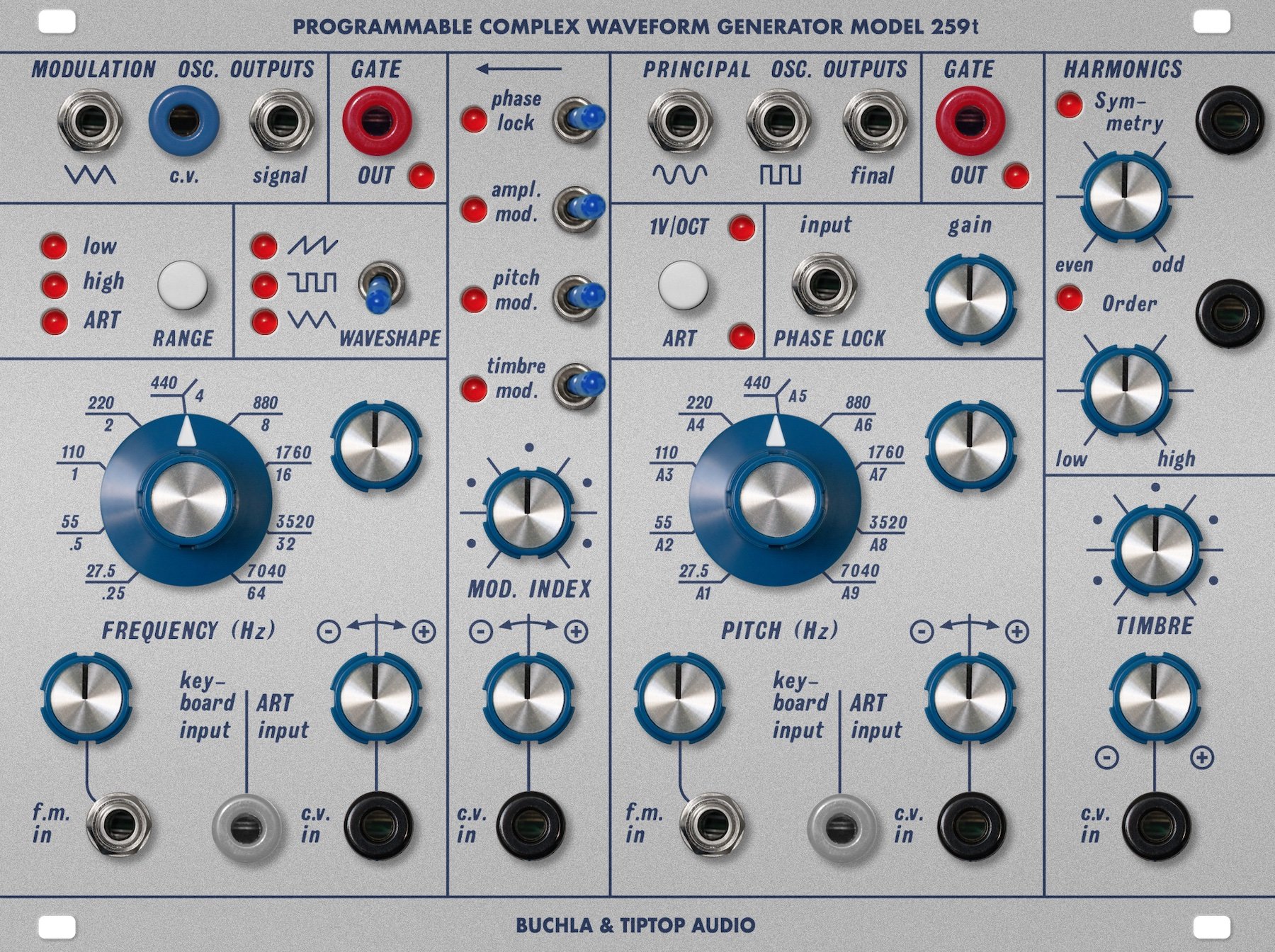
The 259t consists of two oscillators behind a single panel, with the ability to use them independently or cascade modulation from one to the other. As such, they're typically thought of as a Modulation Oscillator and a Principal Oscillator, based on how internal connections may be engaged to create a broader range of timbres. There's also a wavefolder for the Principal Oscillator, which may be adjusted in the Timbre and Harmonics section on the right side of the panel. Frequency, Amplitude, and Timbre modulations may be engaged independently via switches down the middle, with a shared Modulation Index control to dial in the intensity of modulation and thus the resulting timbres.
Foregoing the original 259's autotuning and remote control scheme (which required components from Buchla's 300 Series), Tiptop included capabilities for their new ART protocol on the 259t. Introduced in another line of recent modules, ART is a digital protocol for the precise pitch and tuning control of Eurorack modules. It's similar to MIDI in many respects but transmitted over typical Eurorack patch cables. One of the main advantages of ART is to eliminate hassles that come along with tuning, especially with analog oscillators in polyphonic contexts. As such, multiple 259t modules can be synchronized into beautiful harmony (pun intended), so long as you have a dedicated ART controller module.
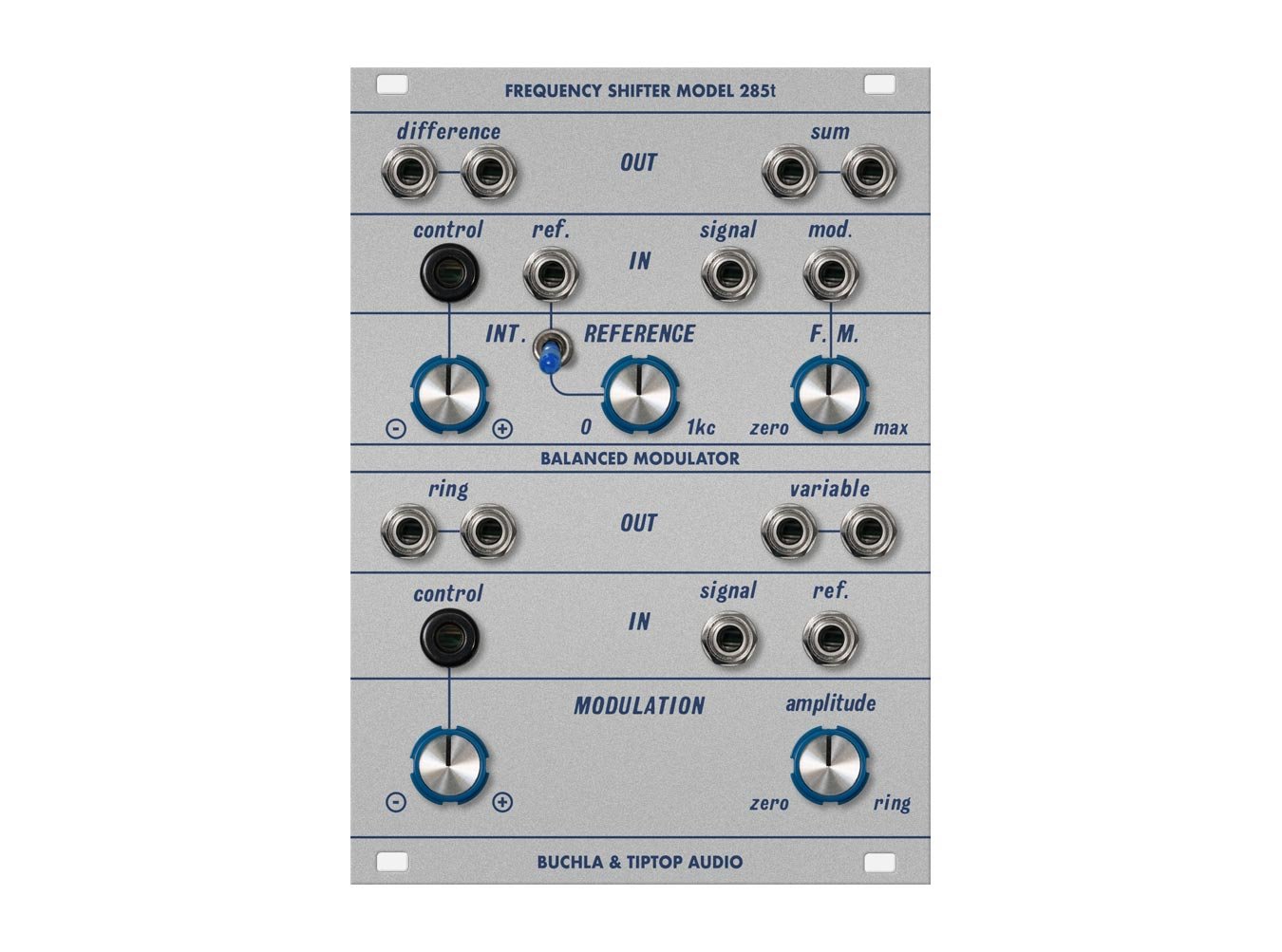
Alongside the 259t, Tiptop Audio is showing off the 285t—a recreation of the classic 200 Series frequency shifter and balanced modulator. Thanks to its internal oscillator, the top section of the 285t can shift the components of any input signal up or down by up to 1kHz—but you can patch in an external oscillator for this purpose as well! The lower Balance Modulator section also puts variable control over the resulting timbres, with an output that morphs from amplitude modulation to ring modulation. It's a module that specializes in metallic clangs and bizarre timbres—a worthwhile addition to any explorative modular synthesizer.
Both of these new Tiptop Audio Buchla modules are expected to be available later this year!
Tiptop: New ART Modules
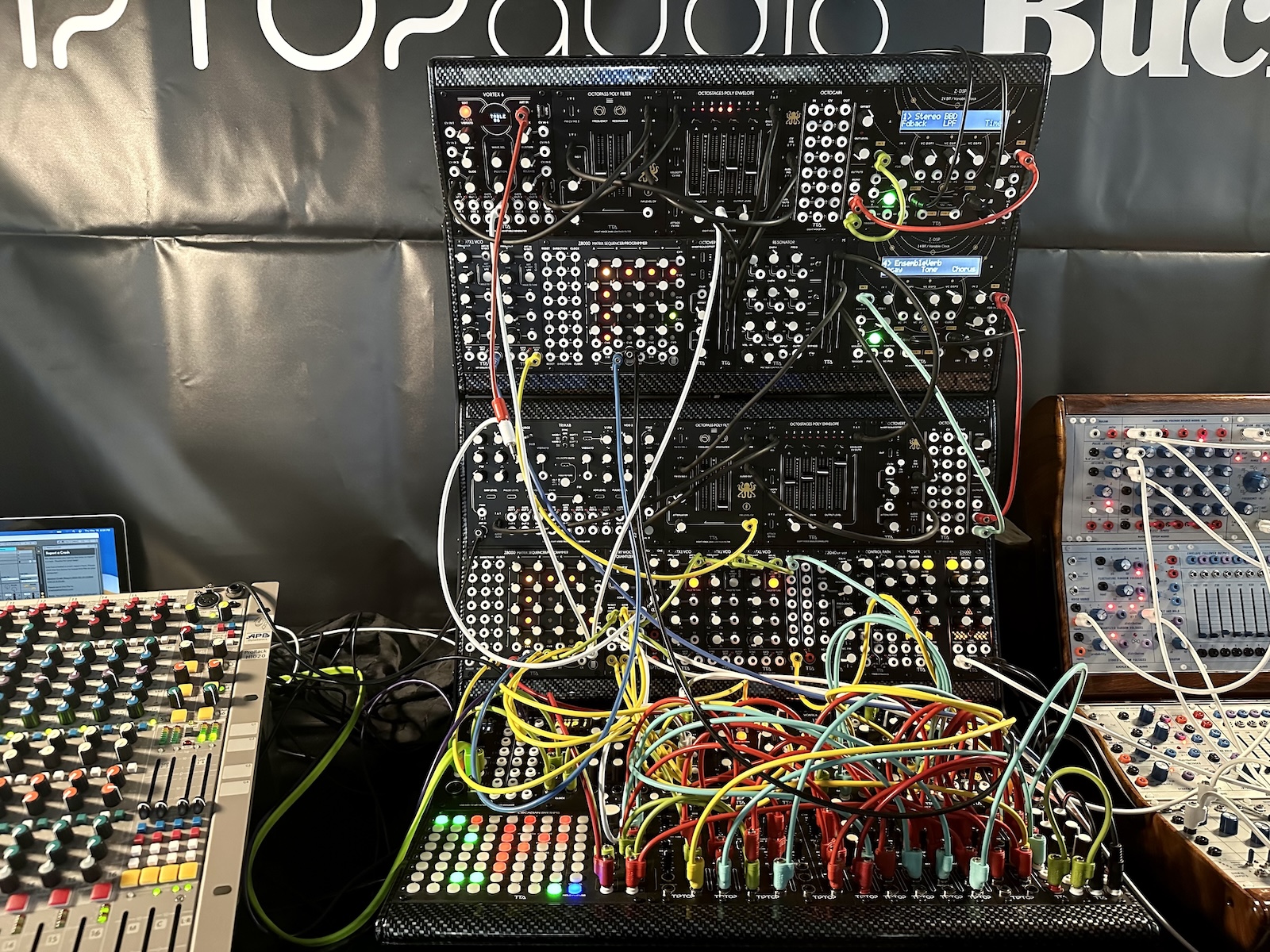
Beyond the new Buchla offerings, Tiptop Audio is moving full-steam ahead with their line of ART modules. In addition to the news that some of their previously announced polyphonic modules are to begin shipping, a handful of new ART-capable designs are being shown this year. If you're new to what ART is about and the advantages it can bring to coordinating many voices inside of modular synthesizers, be sure to check out our dedicated overview article to wrap your head around it.
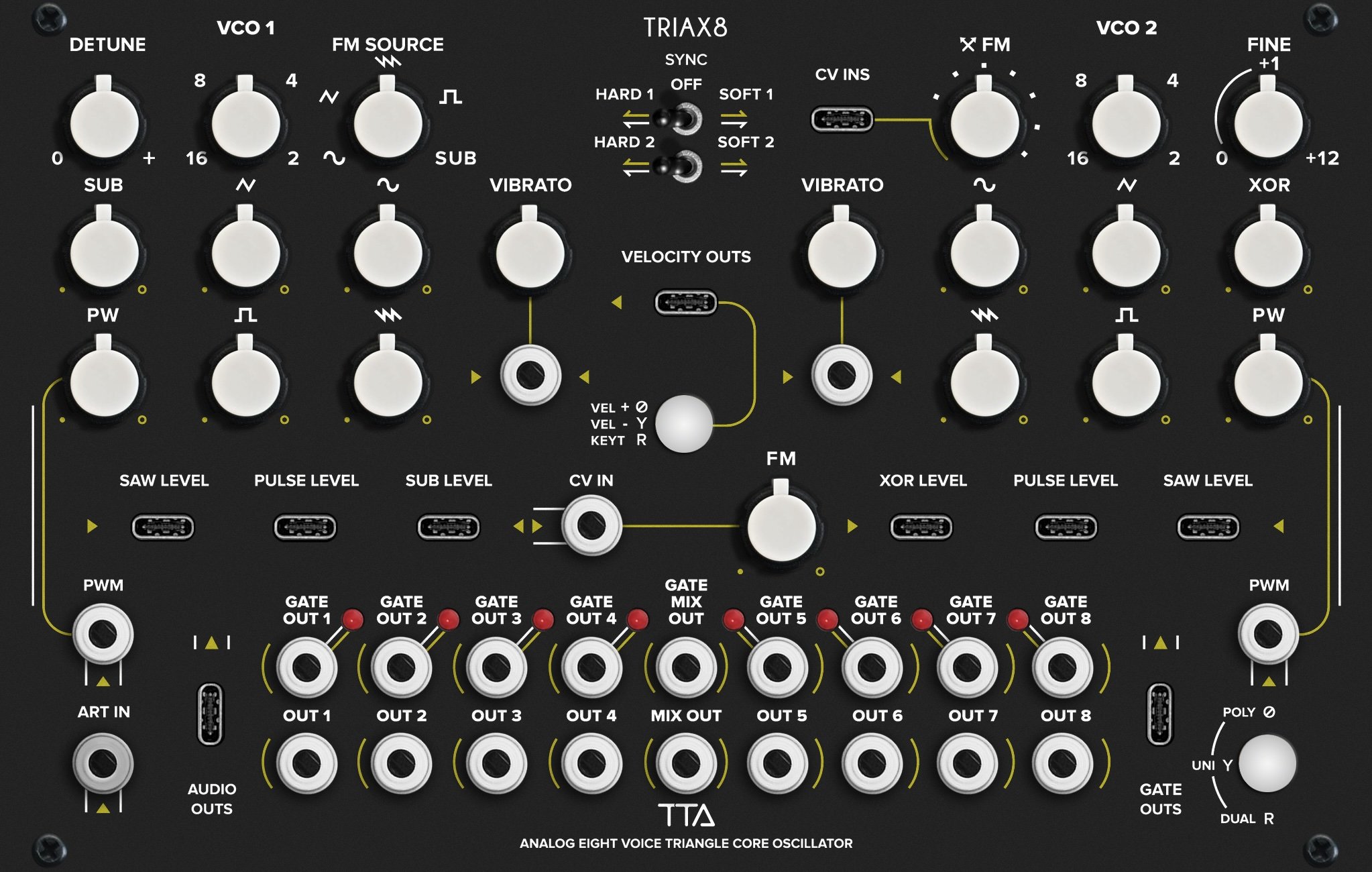
The fully-analog counterpart of their upcoming PPG-inspired VORTEX 6 module, the new Triax8 is an eight-voice polyphonic module with a staggering amount of sonic possibilities packed inside. Loaded up with an abundance of the SSI2130 VCO chips, Triax8 contains no fewer than 16 oscillators inside and is equipped for polyphonic thru-zero FM and a variety of different simultaneous waveforms. This module also makes generous use of the new PolyTip cable format, a USB-C-style connector repurposed as an eight-core audio cable, facilitating the individual control of all eight voices across a single cable. You can then patch each voice output independently with the traditional 3.5mm jacks, or patch them into more PolyTip modules with the consolidated outputs.
While not obviously an ART module itself, the new VC-Resonator module is one that will certainly pair well with the growing line of polyphonic designs. Inspired by the circuit found in the Polymoog, Tiptop's Resonator is a flexible array of three filters, each configurable into lowpass, bandpass, or highpass responses. And unlike the resonator found in the Polymoog, this design is highly adept for modulation thanks to an abundance of control voltage inputs.
Finally, Tiptop is extending the ART utility range with the humble M and Octovert modules—Polytip-equipped multiples and attenuverters, essential tools for making the most of polyphonic patch connections.
Along with the upcoming Buchla modules, Tiptop is expected to begin rolling out these new ART designs this year, starting in the summer and extending into the fall.
UDO Super 8
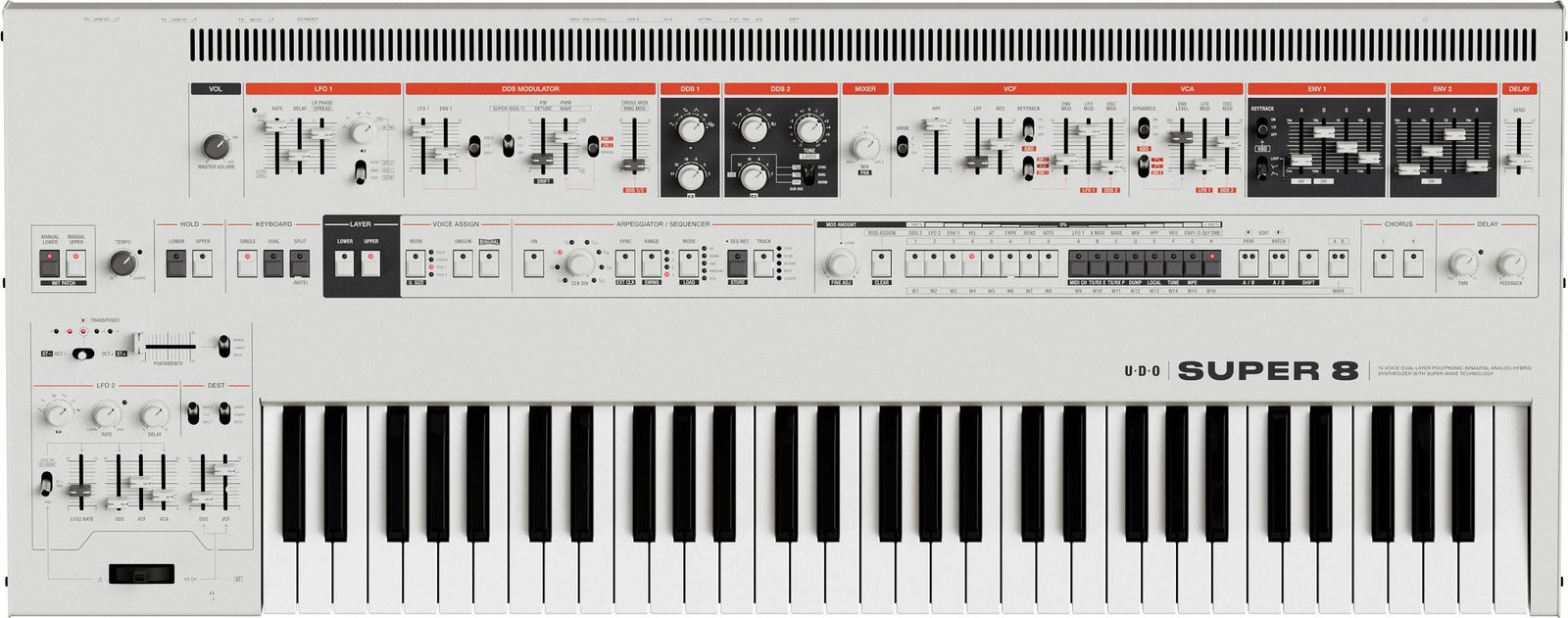
UDO has blessed another machine with their beautiful sounding hybrid synthesis architecture. The Super 8 completes the UDO’s trio of binaural synthesizers, packing most of the power of the Behemoth Super Gemini into a more manageable form reminiscent of the Super 6. Many of the best features of the Super Gemini have all been retained in the 16-voice Super 8, including support for dual-layer bi-timbral patches, the Gemini’s robust performance section, and, of course, a 61-key polyphonic aftertouch keybed. However, due to a reduction in size and price, some things did have to go, most notably, four of the Gemini’s 20 voices, the second set of synth layer controls, and the touch ribbon. Thankfully, switching between layers is a quick one-knob affair, and UDO has mentioned the possibility of a future four-voice upgrade for the Super 8.
Of course, it wouldn’t be a UDO synth without Binaural Mode, which pans the Super 8’s voices hard left and right, after which, sonic differences between the panned voices via modulation open the door to unrivaled explorations of stereo width. On the Super 8, Binaural Mode is layer-specific, so you can have Binaural Mode on one or both layers.
The Super 8 undoubtedly fills a sweet spot in the UDO product line. It’s an ideal compromise between the gig-friendly portability of the Super 6 and the incredible power and feature set of the Super Gemini. It’s no secret that UDO founder, George Hearn has hit a home run with his FPGA fed hybrid synthesizers; they sound absolutely gorgeous with a completely unique sonic quality you cannot find in anything else. We’re happy to see this family of Super synths completed by the Super 8—and it's up for preorder now!
Verbos Electronics Sawtooth Stack
The Verbos Electronics bungalow is abuzz with the wild tones from their newest module: the Sawtooth Stack! As you might guess from the name, Sawtooth Stack is a wild stack of oscillators great for creating huge, buzzy, detuned tones, trance-like leads, and wild drones.
In essence, Sawtooth Stack is a full synth voice. It includes two loopable rise/fall-style envelopes, each with dedicated CV and end pulse outputs. The oscillator section offers a macro control for the frequency of the five (yes, five!) internal oscillators—all based on the sound/behavior of the famously fantastic Verbos Foundation Oscillator. You also get a continuous control for Spread, which imparts detuning onto your sound for rich, evolving tones. The Harmonics section gives you continuous control for Richness and Timbre—two methods of continuously varying the waveshape of the group of detunable oscillators. From there, you get an output amplifier and stereo output with a dedicated final level control.
All logical parameters are voltage controllable and feature dedicated attenuverters, allowing for easy integration into any Eurorack system. Unlike any prior Verbos module, though, Sawtooth Stack also features MIDI input—allowing you to use external MIDI sources to address the envelopes and oscillators, and CCs to address specific parameter values (note—we've confirmed with Verbos that Sawtooth Stack is monophonic, even under MIDI control; there is no way to polyphonically address the individual oscillators). Additionally, Sawtooth Stack can be used in its own standalone enclosure—making it a great choice as an entry into the Verbos universe or patchable synthesizers altogether.
Details on Sawtooth Stack are minimal at the moment—we're especially curious to learn more about the details of the MIDI implementation. We'll update once more info is available!
Warm Audio: New Gear
Warm Audio has recently announced a few additions to their lineup of pro audio gear—including two new mics and an inline preamp. They're all up for orders now!
The WA-19 is a faithful recreation of the AKG D19 prominently used from the 1960s till the present for both live and studio applications. A lot of the WA-19’s magic comes from a super high quality transducer, which’s features solid metal construction built by hand and calibrated with care. It gives the WA-19 a knack for capturing high frequencies that’s rare in a dynamic microphone. A built-in variable high-pass filter further nudges this unique mic into roles typically assigned to condenser mics.
The WA-44 ribbon mic delivers the sound of the original 44-style mic heavily used in broadcasts in the 1950s as well as by the biggest acts of the day, such as Elvis Presley and Nat King Cole. The sound of the WA-44 is classically vintage with a strong bass response, rich mid presence, and gracefully rolled-off highs. Applications for the WA-44 cover a wide range as this mic can sound great on vocals, pianos, as drum overheads, as a room mic—there’s a lot of experimentation to be had. 44-style mic use has been hindered heavily by a lack of accessibility, so hopefully, we’ll be hearing more of this vintage flavor with this Warm Audio release.
Warm Audio’s new Warm Lifter gives your signal a clean boost when using mics that need a little more gain. Such use cases pop up often with some dynamic mics and many ribbon mics. The Warm Lifter will give your signal a 26dB clean boost and features a built-in highpass filter and presence booster to tame lows and compensate for high-end roll off.
WMD Performance Mixer MKII
WMD is back at Superbooth this year with the highly-anticipated Performance Mixer MKII and accompanying expanders. For those who don't recall—after the onset of the global pandemic, WMD wound down operations, leaving many to believe that they were going out of business permanently. Last year, however, William Mathewson returned to Superbooth to announce that WMD was coming back—in fact, we published a deep interview with him, which you can read here. At the time, he announced plans for a new version of the WMD modern classic Performance Mixer...and this year, it appears in its final form, ready to preorder now.
The Performance Mixer MKII is, quite possibly, the ultimate Eurorack mixer. As its name implies, it's geared toward live performance—but of course, especially with the addition of the DB25 direct out expander, it is a solid addition to any studio as well. Performance Mixer MKII features eight stereo channels, each with gain control, two aux sends, panning/xfade control, level control, and mute control. It offers group and cue features, and offers voltage control of aux send levels, panning, and channel level for every channel. It also offers a headphone output, MIDI integration, and a variety of features that should make it at home in dang near any Eurorack setup in need of extensive mixing possibilities.
The build itself is, of course, excellent, and the physical design conducive to longevity and playability. All jacks are located to the left side of the module, keeping the main manual controls for all channels easily accessible, even in the densest of patches. Behind the panel, it features a modular design—so if you ever develop issues with a specific channel years down the road, it's easy to swap the channel out with a new one without needing to send in your entire mixer for maintenance. (That is a super nice touch.)
Along with Performance Mixer MKII comes the announcement of two new expanders: PM Channels MKII and PM DB25 MKII. The Channels expander gives you four additional channels with all the features of the main unit; the DB25 expander gives you pre or post-fade outputs from the individual channels, perfect for multitrack recording scenarios.
We're thrilled to see this amazing performance tool return—and we're thrilled that it appears to be better than ever before. Performance Mixer MKII and DB25 MKII are up for preorder now—but Channels MKII is still undergoing final development.
WORNG Electronics SideCar
We're big fans of open-ended modules that offer useful functionality on their own, but are also serendipitous pairings with others. That's exactly what's going on with the SideCar module by WORNG Electronics—a new design making its debut this year at Superbooth 2024.
SideCar is a six-channel VCA, offering four mono and two stereo channels. Thanks to its 45mm faders, which are fairly long-throw for a Eurorack module, SideCar is highly performable for anyone that enjoys riding faders. WORNG also took special care in designing the module's response to external control voltages, ensuring that you'll have optimal headroom and receptiveness to snappy envelopes.
SideCar might seem like any other VCA module, and while they say "you can never have too many VCAs," this module might make more sense when viewed in a context with other WORNG modules. Consider SoundStage or their slimmed-down collab with ALM Jumble Henge—unique mixer paradigms without channel level controls, but something easily extensible with a module like SideCar. Alternatively, set it up next to their LRMSMSLR for manual control over your mid/side encoding, or mix and match waveform outputs from Acronym. In any case, SideCar also streamlines patching thanks to internalized summing and cascading across inputs and outputs, so you can reduce patch cable spaghetti while you're at it.
SideCar is available for preorder now!
Xaoc Devices Berlin
The new Xaoc Devices Berlin might look simple at a first glance—but looks can be deceiving. Though it is indeed capable of acting as a more-or-less typical audio oscillator, it has a lot of tricks up its sleeve.
In terms of basic features, Berlin is an eight-bit digital oscillator with dedicated square and saw outputs. It includes dedicated octave switches and a large front-panel fine-tuning knob with a range of +/- 12 semitones. It also features a 1V/octave input, an FM input with attenuator, and a hard sync input. Octave selection may also be voltage controlled. So that...sounds pretty basic, right?
Well, there's a bit more to it than that. For one, Berlin has a 20-octave range (!!)—going down to 30 seconds per cycle and all the way up to 250kHz (yes, you read that correctly). This is, frankly, an absurd range for most sound-based purposes...but the key lies in Berlin's linkage to other modules in Xaoc's Leibniz subsystem—a set of modules designed for exploration of analog-to-digital and digital-to-analog conversion, as well as the transformation and manipulation of multiple bit streams in your modular system. If that sounds complex, don't worry: while folks who have bought into the Leibniz subsystem will no doubt welcome a high-frequency clock source. However, even for folks who aren't getting deep into Leibniz modules, Berlin presents an interesting opportunity for deep timbral exploration when paired with a couple of specific Leibniz modules. Let's explore that idea briefly.
One of the most logical pairings for Berlin is Jena, the Leibniz subsystem's "binary transfunctioner." In essence, Jena stores a large number of data arrays (called "shapes"), organized in banks. When Berlin is connected to Jena, you can activate the LBZ Link function to produce the currently-selected Jena shape at Berlin's Saw/LBZ Wave output. So, in essence, the pair becomes an eight-bit wavetable oscillator—with a variety of CV inputs available on Jena for the continuous evolution of your waveform. This can result in some truly gnarly and remarkable lo-fi sounds reminiscent of vintage wavetable synths like the PPG Wave...so if you revel in the intense tones possible from crude-yet-beautiful digital synthesis, give this a look. Of course, this is just the very surface—Berlin can also be paired with Rostock, a 64-step shift register, for even more peculiar and experimental timbral evolution; and no doubt, adventurous musicians will soon show us many more of the possibilities that the Berlin's Leibniz integration can afford.
XOR Dual Chord + ART NerdSEQ Expanders
The NerdSEQ ecosystem grows larger at Superbooth 2024—XOR Electronics, makers of the extensible tracker-based sequencing platform, are showing off the latest expander modules for the NerdSEQ family.
Dual Chord is a highly-packed expander module for the NerdSEQ, containing two four-voice oscillators that may be meticulously controlled by different tracker lanes on the main module. A total of 32 waveforms may be simultaneously produced by the module, leading to incredibly rich timbres and harmonies to feed into other modules in your patch. Though there's a lot packed inside of this module, with only a few knobs on the panel, every aspect is controllable from NerdSEQ. It's effectively a little companion synthesizer for your tracker setup!
But perhaps a bit more unexpected was the upcoming ART expander for the NerdSEQ. Yes, ART as in the Tiptop Audio ART protocol—like the DualChord expander which can be controlled polyphonically, this ART Expander facilitates connection to modules like Vortex6 and the upcoming Triax8. If you've already got a NerdSEQ and you're interested in polyphonic Eurorack modules, or you're looking for a specific style of sequencing and controlling your ART rig, NerdSEQ is now an excellent option to explore.
Neither of these expander modules are available just yet, but stay tuned for them soon!
More on the Way!
Don't fret—Superbooth is still just ramping up. We'll continue adding to this page as new developments emerge...so stay alert and keep your finger on that page refresh button! This party is, as they say, just getting started.





